 |
South India
Part 1: Tamil Nadu - Temples and Beaches
February 2008
|
Our route from Chennai through Tamil Nadu and Kerala, and up to Bombay,
part 1 - the Coromandel coast: Chennai, Kanchipuram, Mamallapuram, Pondicherry, Chidambaram, Thanjavur, Trichy, Madurai, Rameshwaram and Kanyakumari.
(Link to part 2 is at the bottom of the page)
|
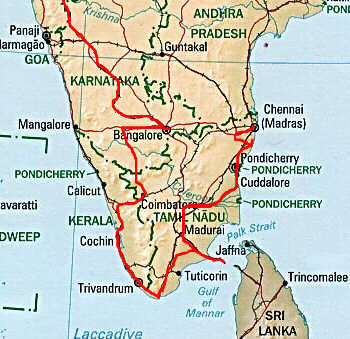
|
Chennai (Madras)
|
Mon 28 Jan. Why do our flights to India always arrive at one o'clock in the morning? Nevertheless we had no trouble getting a prepaid taxi ticket from the booth outside the airport, and the taxi took us to the hotel in Chennai (Madras) that we'd chosen from the guide book. That one was full but they took us just down the road to the Hotel New Victoria where we got a spacious room for £28, including breakfast and quite a lot of local city taxes. We woke up at 8:30 in time for the breakfast buffet, discovered 'Idlis' a favourite south Indian snack and promptly forgot them, then set out to explore Madras. The hotel is only 200 yards/metres from Egmore railway station so we got the local suburban train to go to George Town, the oldest part of the city. A lady, trying to be helpful, told us to get off at Beach station rather than Fort station, which meant we had a rather long uninteresting walk back into George Town, where we found that little of the Raj era remains - there are few of the type of grand colonial buildings that are scattered around Calcutta. Eventually we ended up inside the fort (where we had to sign in first because it is still a military post), where the real old centre of the city is - the church where Robert Clive got married, the Government House, Clive's house (a very nice old building which is now a government pay accounts office), etc. Tired out we got a tuk-tuk (motor rickshaw) back to the hotel.
While Sheila had a nap I stepped across the road to the popular Saravana Bhagan restaurant, where I fell for the upsell - I ordered a massala dhosa, but the waiter persuaded me to get some sort of giant dhosa which was half a metre long. It was very good, and fortified by that and a lime soda I walked the couple of kilometres to Anna Salai Road and the nearby Taj Connemara, the old-fashioned British-era hotel, which still retains its colonial charm in an up-market sort of way. I sat on the terrace under the palm trees by the swimming pool and had a pot of tea. The Connemara hotel still retains its charm, while the street life passes by outside. |
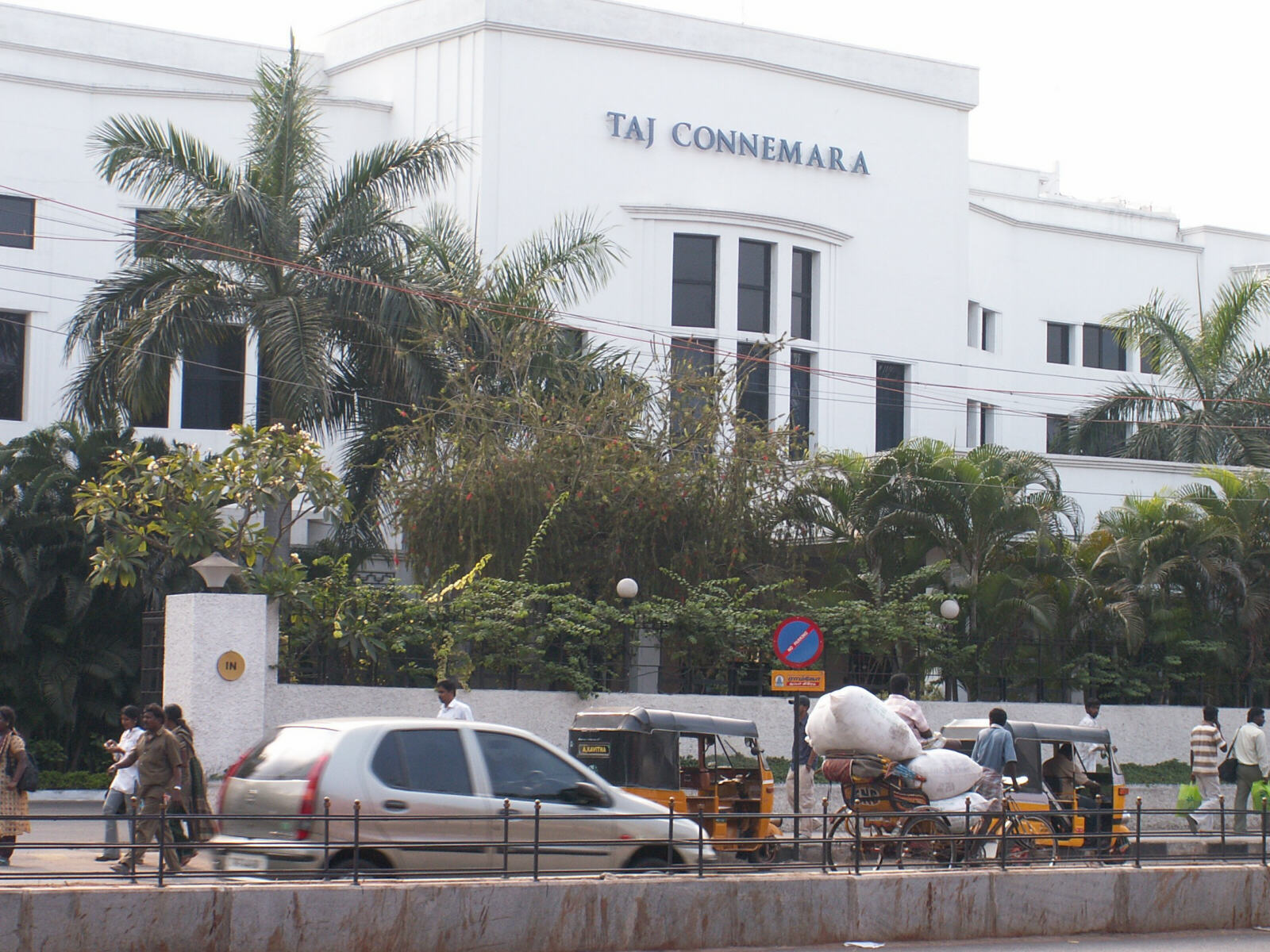
|
On the nearby main road I waited at a bus stop and fought my way onto a packed city bus, which for five pence took me all the way back to Egmore station, an interesting experiment which I probably won't repeat. In the evening we walked up Kennet Lane, our local street, and negotiated a car for the next day's tour, then I was forced by Sheila to have a haircut at the little booth at the end of the street (30 pence). We had a very nice butter chicken curry at the restaurant in nearby hotel Pandian. |
Kanchipuram
|
Tues 29th. The taxi (all taxis seem to be white Ambassadors, in a very 1950s-Austin style) took us the two-hour drive to Kanchipuram, one of the seven sacred cities of India, where we started our 'Temple Tour'. The first thing we did as we got to the temple was to buy some leather sandals from the shoe-sellers outside the temple, because the ones we brought with us were killing us. Having bought two pairs for 250 Rupees each (£3, 4 euro), another man immediately came up and hammered big tacks into the strap joins to 'strengthen them' for another 50 Rupees each! The first temple, Sri Ekamberanathar, is large, with the standard plan of Tamil Hindu temples. Inside the outer walls with Gopurams above the entrance, a series of chambers in the temple itself leads you towards the inner sanctum, which is only open to Hindus. Around the central 'avenue' through the temple are side chapels and courtyards, in one of which was a mango tree reputed to be 3,500 years old.
|
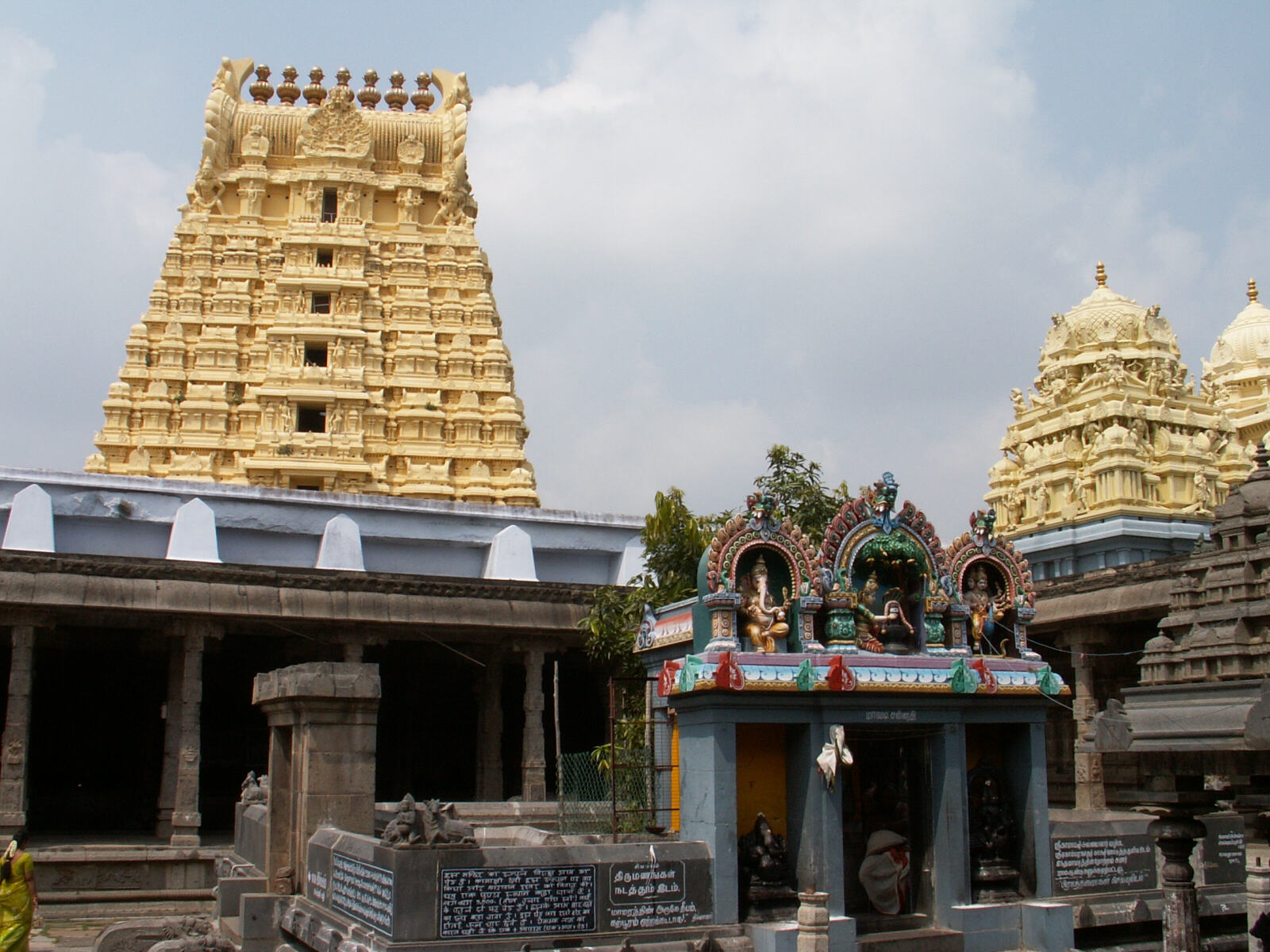
|
Unfortunately most temples close between midday and 4pm, and when we attempted to visit the other temples in town we couldn't get in, so we carried on to Mahabalipuram, stopping for a 'thali' lunch on the way, which we ate with our right hands like everyone else in the little restaurant - it was very tasty. |
Mahabalipuram (Mamallapuram)
|
We arrived in Mahabalipuram, now renamed Mamallapuram, and instantly liked it. It is basically a fishing village but because of the picturesque 'shore temple' perched on a rock by the sea, and because of the beach, travellers and tourists have been coming here for years and there are now dozens of beachside restaurants and small guest houses. It is very relaxed and we met people who had been staying here for months. It's probably like Goa must have been before the tourists started arriving in plane-loads. We stayed at the Santana guest house on the beach, with a view from our room of the fishing boats and the shore temple. |
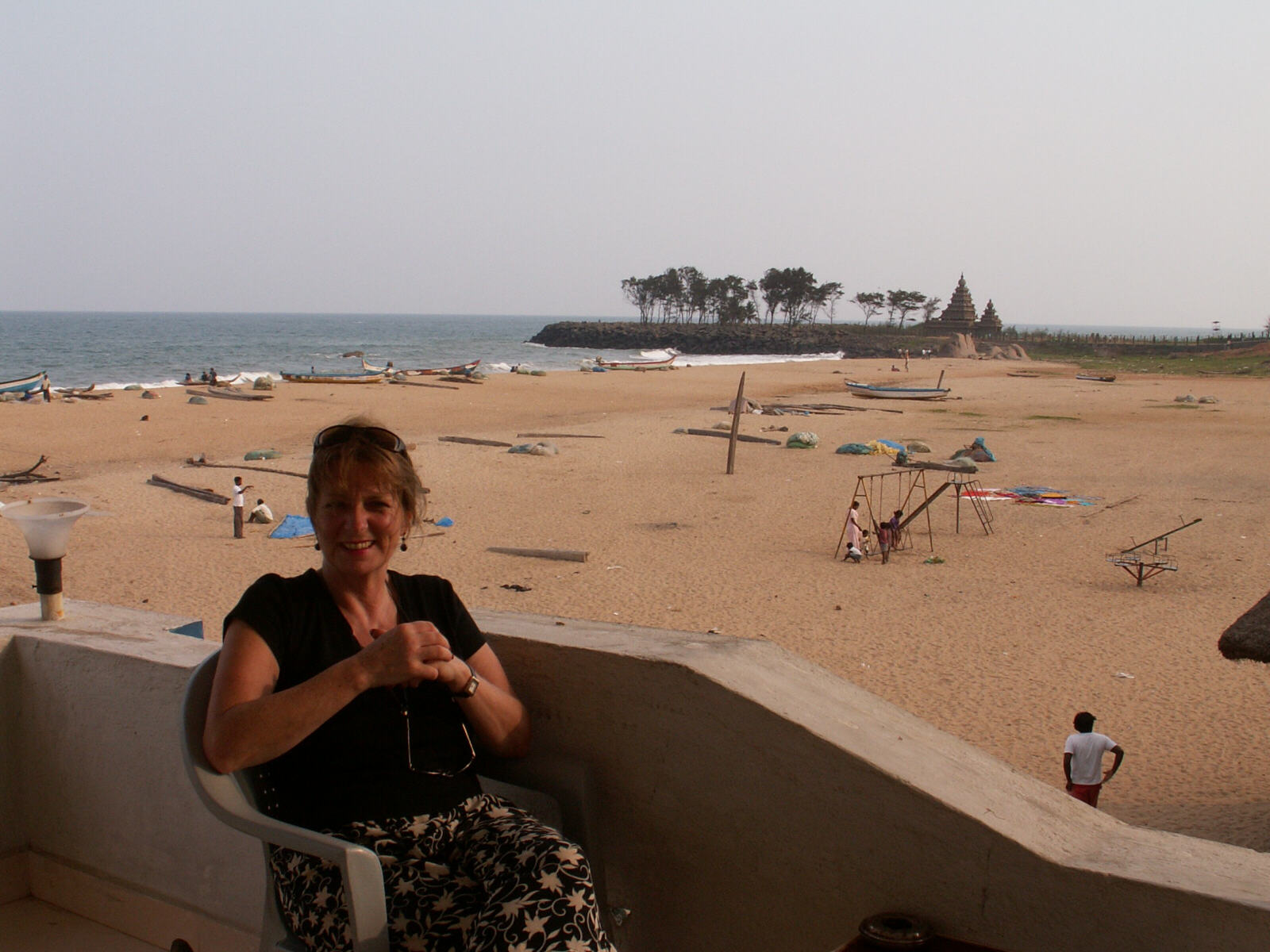
|
Mahabalipuram is very relaxed, with plenty of beachside cafes and restaurants. |
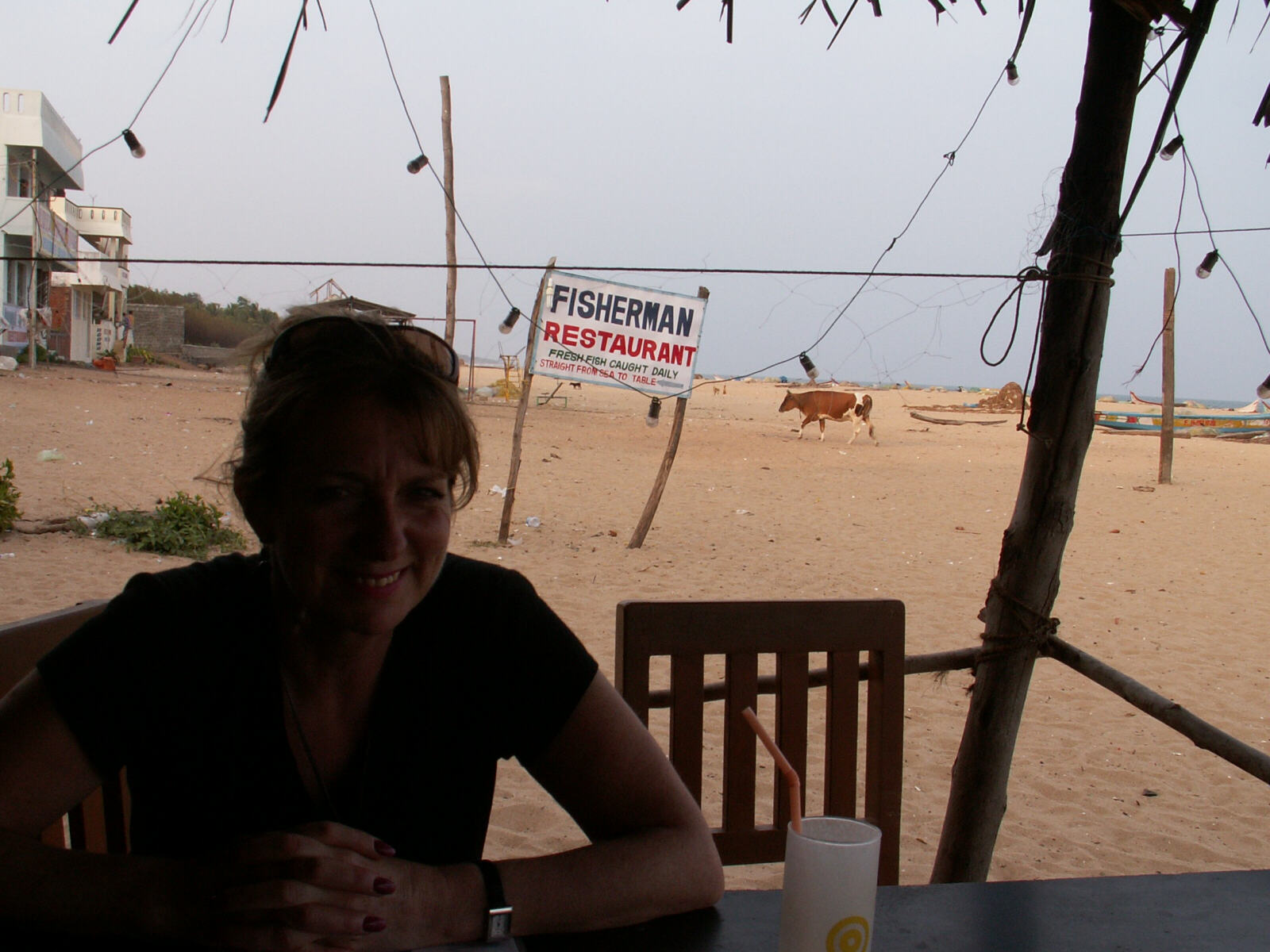
|
We spent the rest of the afternoon strolling along the beach and up the main street past sculptors, silk shops, cafes and restaurants. Back on the beach we went for dinner at the Bob Marley restaurant where we had huge tiger prawns, all caught that morning by the nearby fishermen. It's a very pleasant spot and we spent some time chatting to the friendly owner, except when he had to go to attend to a police raid - technically none of the restaurants in town are allowed to serve beer but they all do, and everyone knows they do, so when the police need to boost their conviction rates they go and raid a couple of restaurants in a half-hearted sort of way. Luckily we and the other diners had all finished our beers and the evidence had gone, so this time the police went away empty-handed.
Weds 30th. We had such a long lie-in that by the time we got up the people in the next room, number 101, had checked out so we immediately moved into their room, which is the best one in the place with the best view in town, one window facing directly out to sea over the beach and fishing boats with the soothing sound of the waves, the other window towards the shore temple. We walked down the beach and visited the famous shore temple, built on a small rocky outcrop beside the sea, one of the oldest temples in India which has amazingly survived all the ravages of wind, waves and tsunamis. Next we got a tuk-tuk for a tour of some of the other sights of Mahabalipuram, especially the 'five Rathas' which is a pretty group of small temples all carved out of bedrock, with incredibly well-preserved carvings because they were buried under the sand for hundreds of years.
|
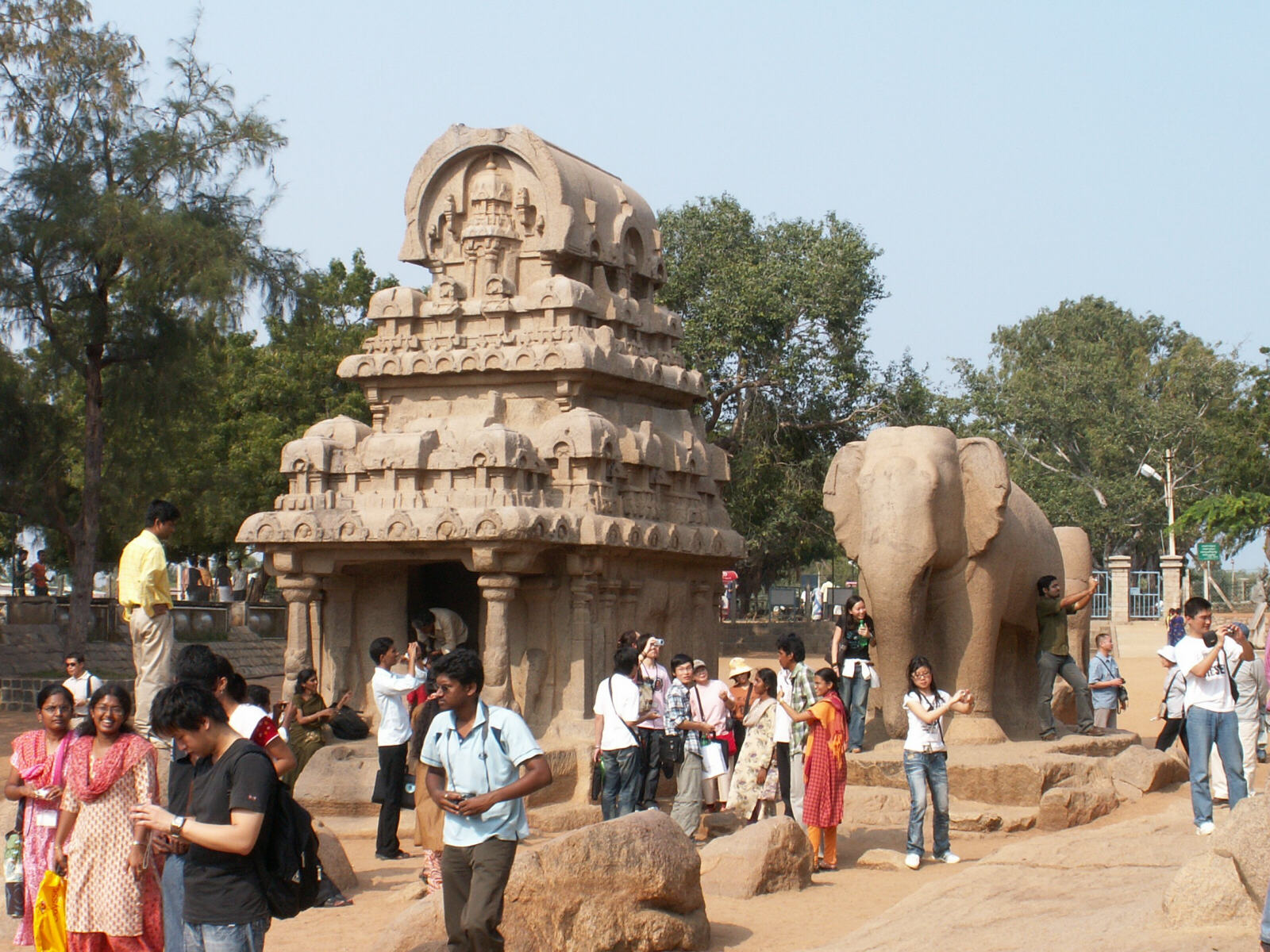
|
Other highlights were 'Siva's butterball', a huge round rock impossibly balanced on a steep rocky slope, and Arjuna's Penance, an elaborate and famous rock carving (shown on all the postcards) which uses a natural fault down the middle to represent the river Ganges.
|
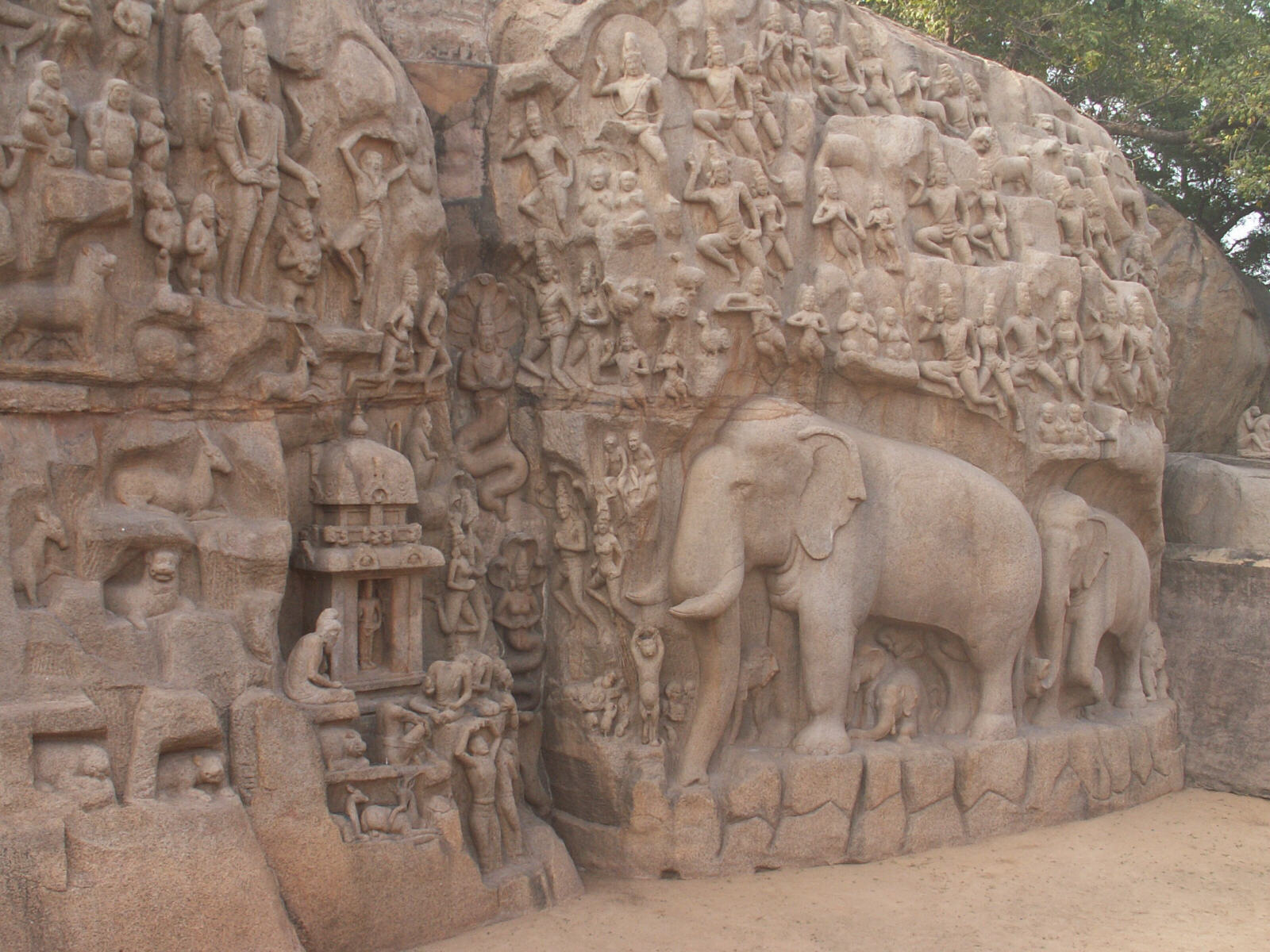
|
After the tour we walked around the town for a while then went for an early dinner at the Moonraker restaurant on the main street and had delicious butter egg massala.
Thurs 31st. We were up earlier today so we walked over the beach to watch the fishermen painstakingly picking the prawns, crabs and little fish out of their nets, taking ages to accumulate a meagre catch that didn't fill their small shopping bags. |

|
We had breakfast of massala omelette (me) and banana pancake (Sheila) at the Seashore restaurant opposite our guest house, then got a tuk-tuk for the 45-minute drive up the coast road to 'Dakshina Chitra', a 'village' created from traditional buildings, arts and crafts from the south Indian states. The houses range from a middle-class merchant's substantial house with heavy dark-wood timbers and elaborately-carved doorways, to a simple, circular mud-built hut with a conical thatched roof which is designed to float during the floods! Below, a traditional house in Dakshinachitra, with canoe at the ready. |
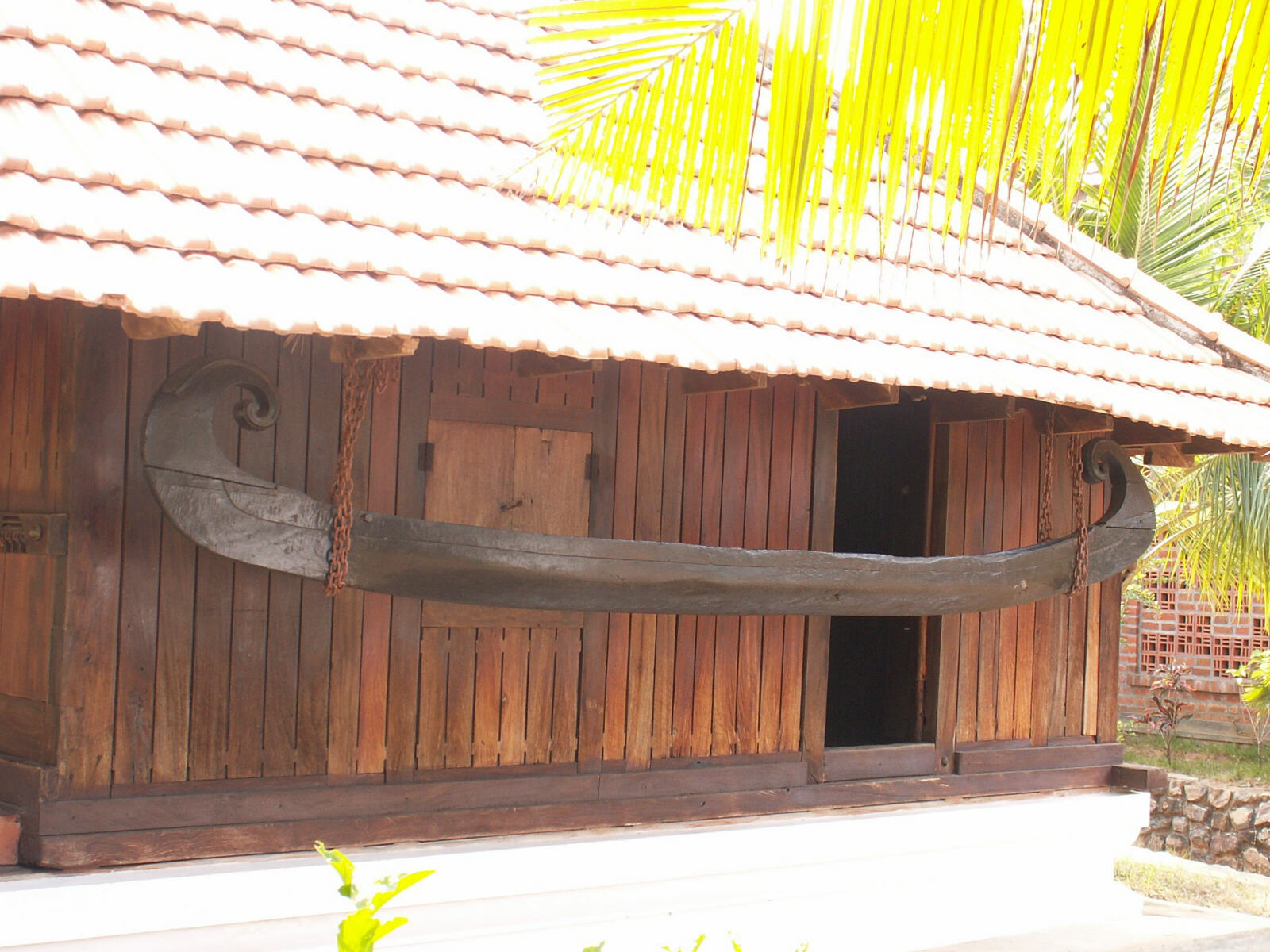
|
If you thought British imperial measures were complicated, what do you make of these Indian weights and measures? |
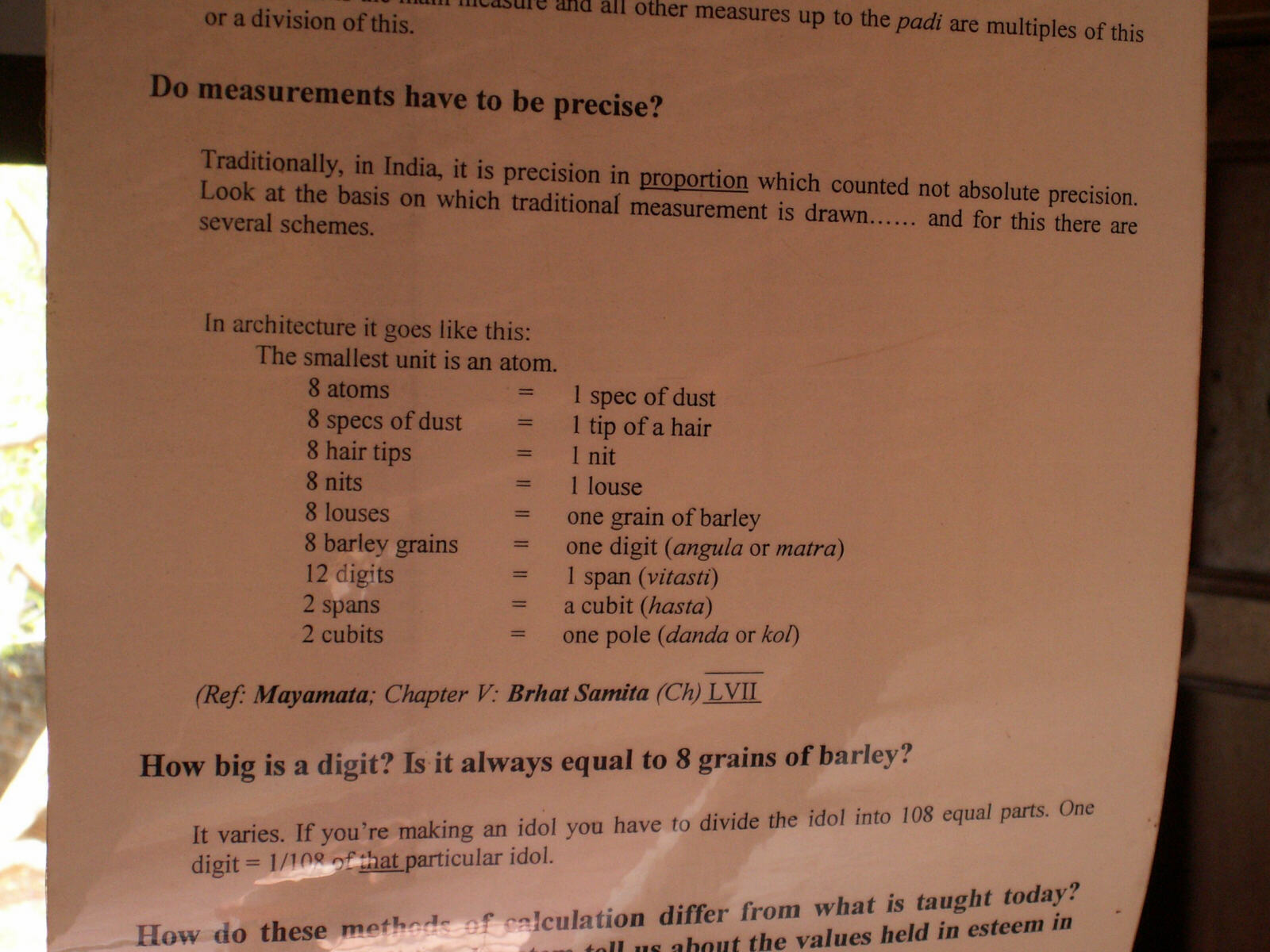
|
On the way back we stopped for lunch at Fisherman's Cove, an up-market Taj-group beach resort with beautiful gardens and an open-air restaurant by the sea. I made the mistake of having an imported beer, which had an extra 73% import tax on top of the already huge price, and Sheila had a lobster bisque which she came to bitterly regret! In the evening we had a nice meal at the rooftop Tina Blue View restaurant then a stroll round the streets and back along the beach. The sound of the waves lulled us to sleep.
Fri 1st Feb. A day at leisure chilling out in Mahabalipuram. We strolled through the village and had breakfast at the Nautilus, a bustling café apparently run by a Frenchman, then Sheila went to the beauty salon to have her eyebrows threaded (40 rupees, about 50 pence). After a nice lunch at the Gazebo restaurant Sheila had a leg wax for 495 rupees and then a nice acupuncture experience for her bad leg (200 Rs) from a Swedish lady with a very nice lifestyle, she worked at home for six months then on holiday in India for the other six months of each year. While all this pampering was going on, I read and had cups of tea in cafes. We had our most 'south Indian' meal so far at the Galaxy restaurant, sitting upstairs watching the world go by in the street below.
Sat 2nd. Another hedonistic day, walking barefoot along the shore, sipping coffee in cafes and chatting with travellers and expats about places to see and places to stay. In the evening the whole place suddenly became very crowded, as the tourists and hippies were supplemented by the weekend crowd from Chennai, Indians and expats, all having a riotously good time in the restaurants and on the beach. |
Pondicherry (Puducheri)
|
Sun 3rd. It was time to move on, so we got a taxi to Pondicherry (now apparently spelled Puducheri officially), 100km for 1,300 rupees. We had heard from many people how all the hotels in Pondi are full, so we were pleased when the taxi driver took us to his favourite, the Malar guest house, which was very new and clean for Rs 1,000 a night. Sheila was still suffering after-effects of the lobster so I went and had breakfast at 'Hot Breads', a café and bakery, then walked around the town, meeting Lakshmi the temple elephant at Sri Manakula Vinayagar temple where there was a service in progress, with lots of loud drumming and horn playing. I walked along the beach in the hot sunshine and back up de Bussy street to the hotel. In the cool of the evening we walked back to the beach, stopping at Madame Shanthi's café for a soup and creme caramel, then took part in the evening promenade along Beach Road, with most of the town's population. After a pizza and a beer on the way back we retired exhausted.
Mon 4th. We caught a cycle-rickshaw to the main market (20 Rs) and spent some time walking through the teeming market hall, especially in the fish market where the noise was tremendous. All the 'fishwives' were yelling at each other at the tops of their voices, and there seemed to be some sort of auction in progress each time a porter carried in a new crate of fish. It all got quite angry and the women, all dressed in wonderful coloured saris, were pointing and gesticulating at each other, while one woman who seemed to be almost in charge, was taking and handing out large wads of money. There were huge tiger prawns by the bagfull .... |
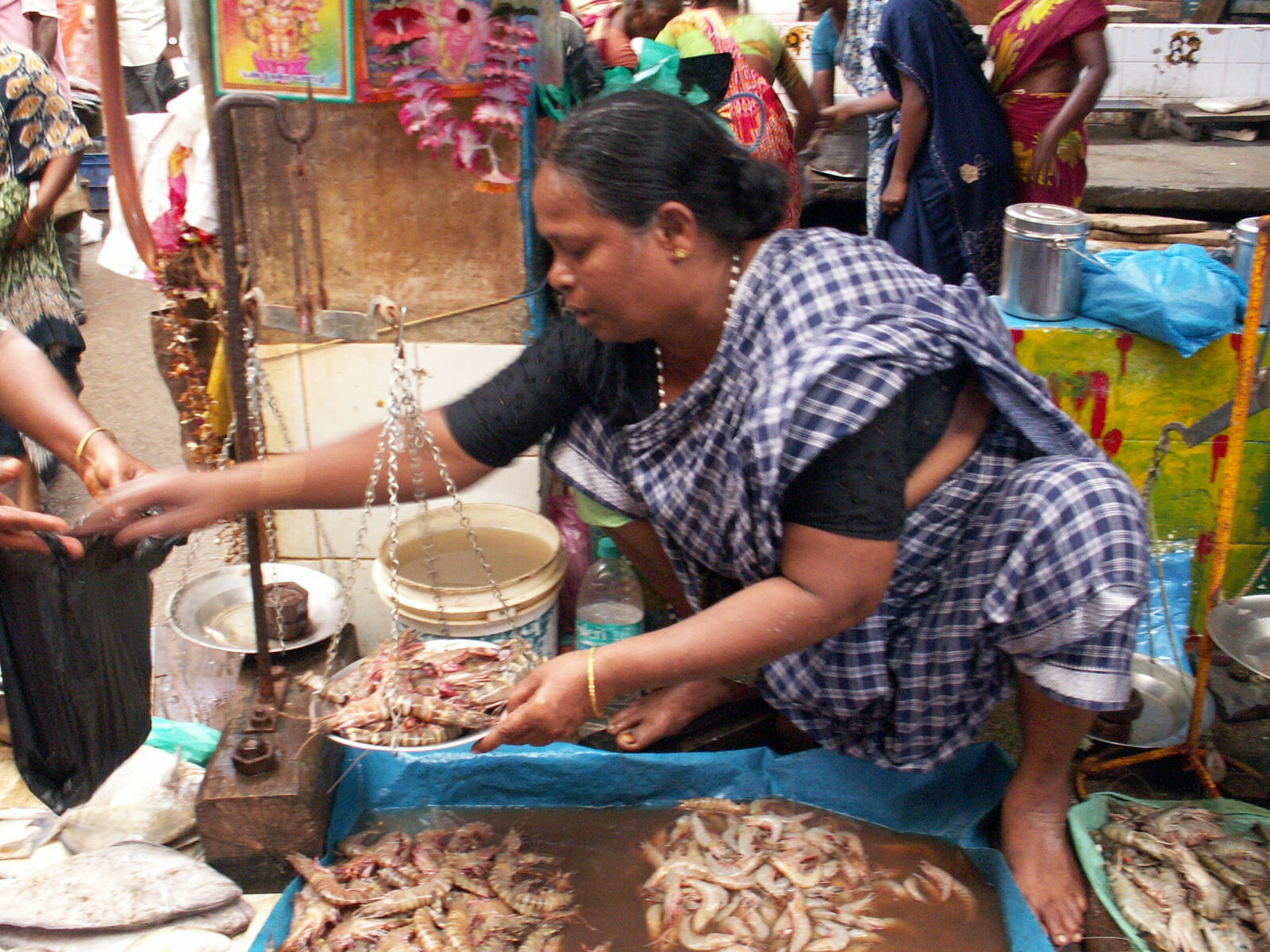
|
.... or you could have this one for a lunchtime snack.
|
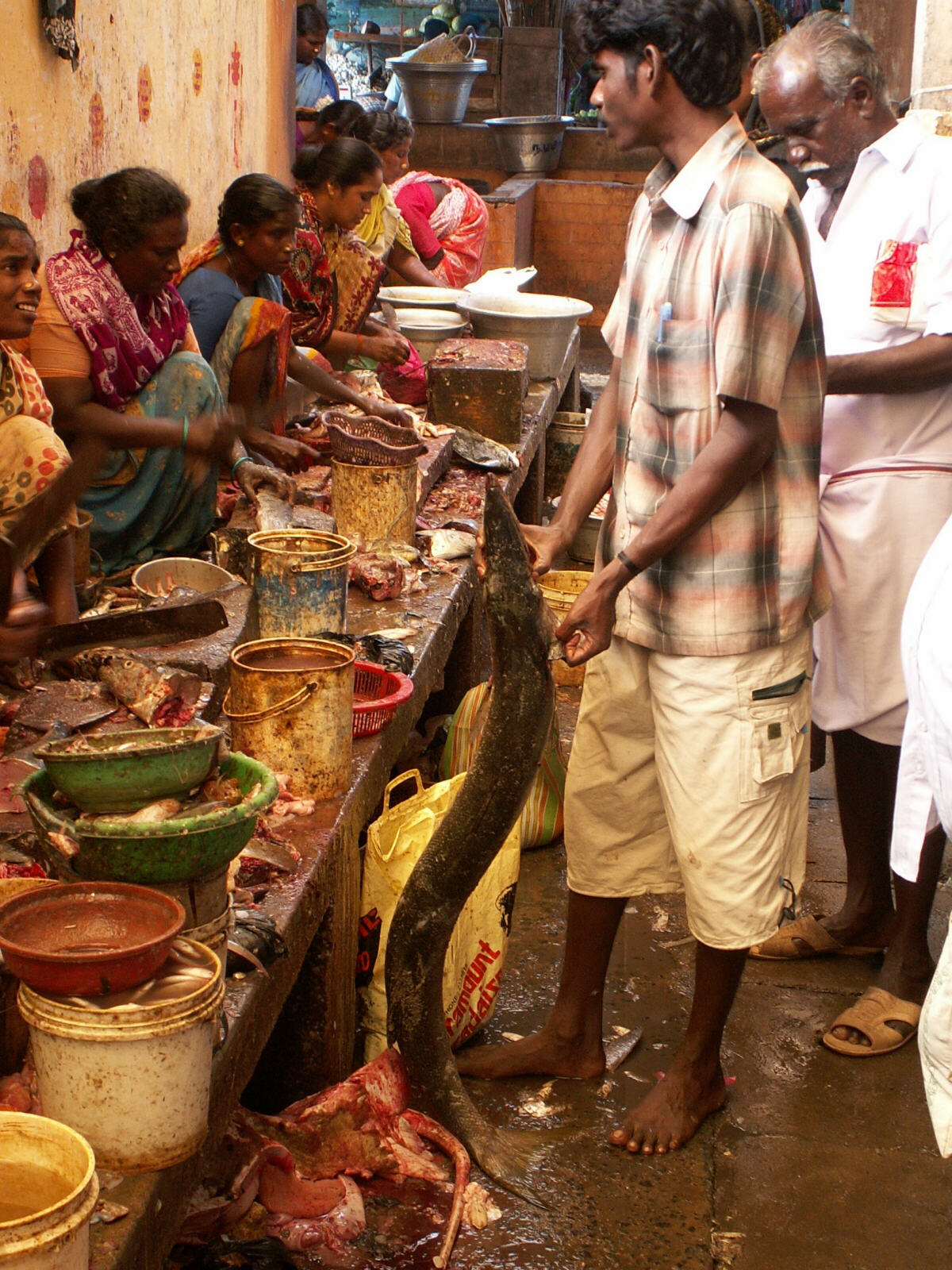
|
As we went down the nearby shopping street Sheila spotted a silk shop and went in to buy some silk for cushion covers. Of course the one she wanted was the one right at the bottom of the pile, and then they oversold us enough material for four cushions (we only needed two) for 695 Rs, plus four zips for 24 Rs. Then we found a nearby tailor and spent some time deciding how many cushion-covers to have, while he measured and chalked the silk in every direction, until we settled on the size and he made them for 50 Rs each. By the time we reached the temple it was closing and Lakshmi the elephant had gone home, so we went to the nearby 'Daily Bread' café and cake shop for a very refreshing brunch of French onion soup and massala omelet. After brunch we set out again to visit Lakshmi, who will bless you with a tap on the head if you put a coin in her trunk. |
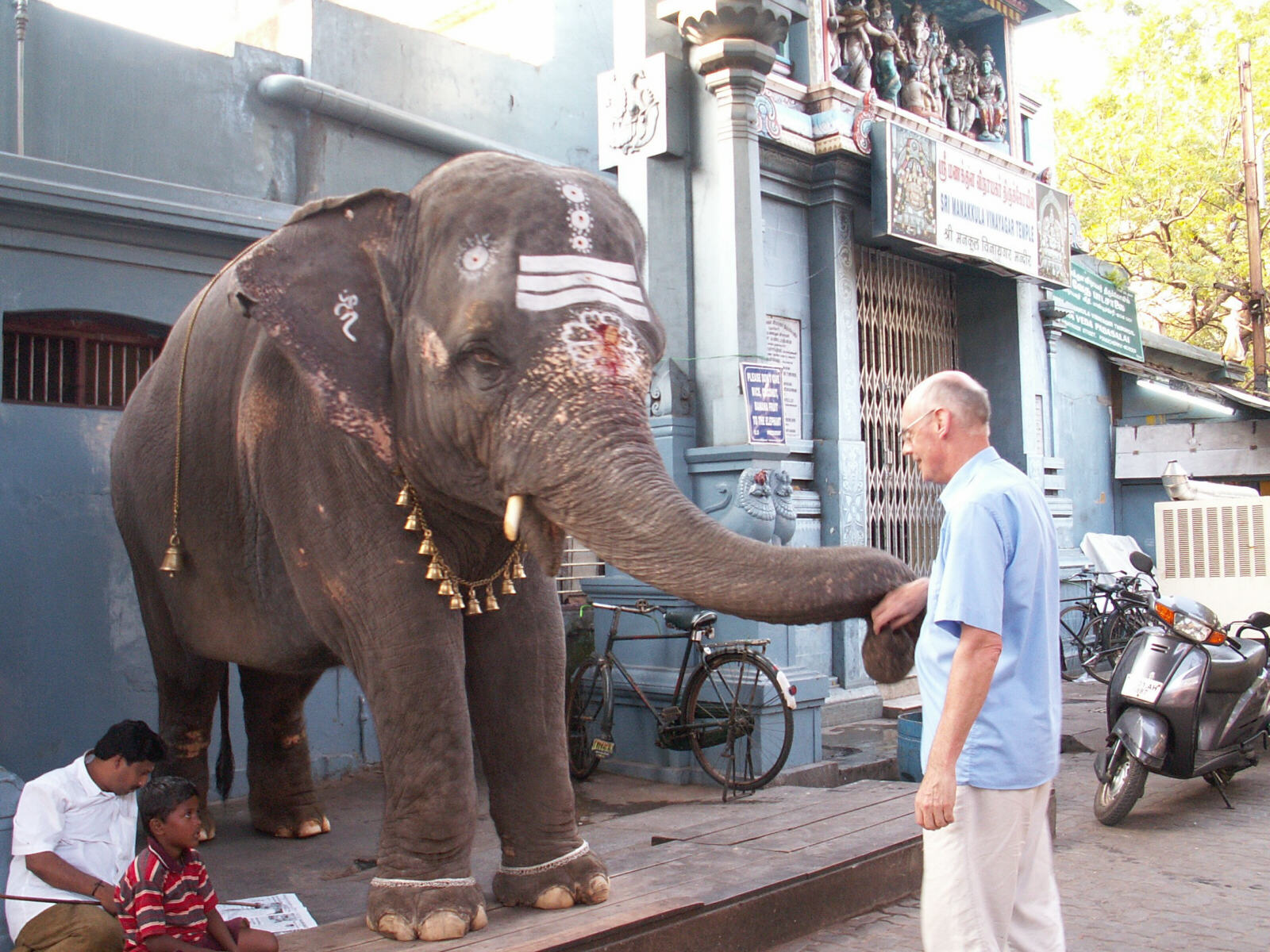
|
We carried on Sheila's shopping spree, visiting various clothes and jewellery shops, then stopped at the up-market Promenade Hotel on the seafront for a drink on the terrace at dusk. After walking along the promenade, which had been closed to traffic, we stopped for dinner at Madame Shanthi's where we had pepper chicken south-Indian style and an egg curry.
Tues 5th. Unfortunately the egg curry did not agree with Sheila at all, so we were incapable of doing much or travelling on today. Sheila didn't feel up to going anywhere, so I strolled around Pondicherry, had a look around the Botanical Gardens which were pleasant and shady but rather run down (there was no charge to go in because the ticket office at the entrance was derelict) then right across town to the elegant French villas near the promenade. I had a light lunch at Hot Breads and later on I risked a chicken biriyani at a little street stall where the food is all cooked up right there on the street (including tandoori chicken from the 'tandoor oven' made of an old oil drum!) |
The Temple Tour
- Chidambaram and Thanjavur (Tanjore)
|
Wed 6th. We went by taxi to Thanjavur (1900 rupees), stopping on the way in Chidambaram to look round the ancient and very impressive Nataraja temple, with its elaborately decorated gopuram (gateway tower). |
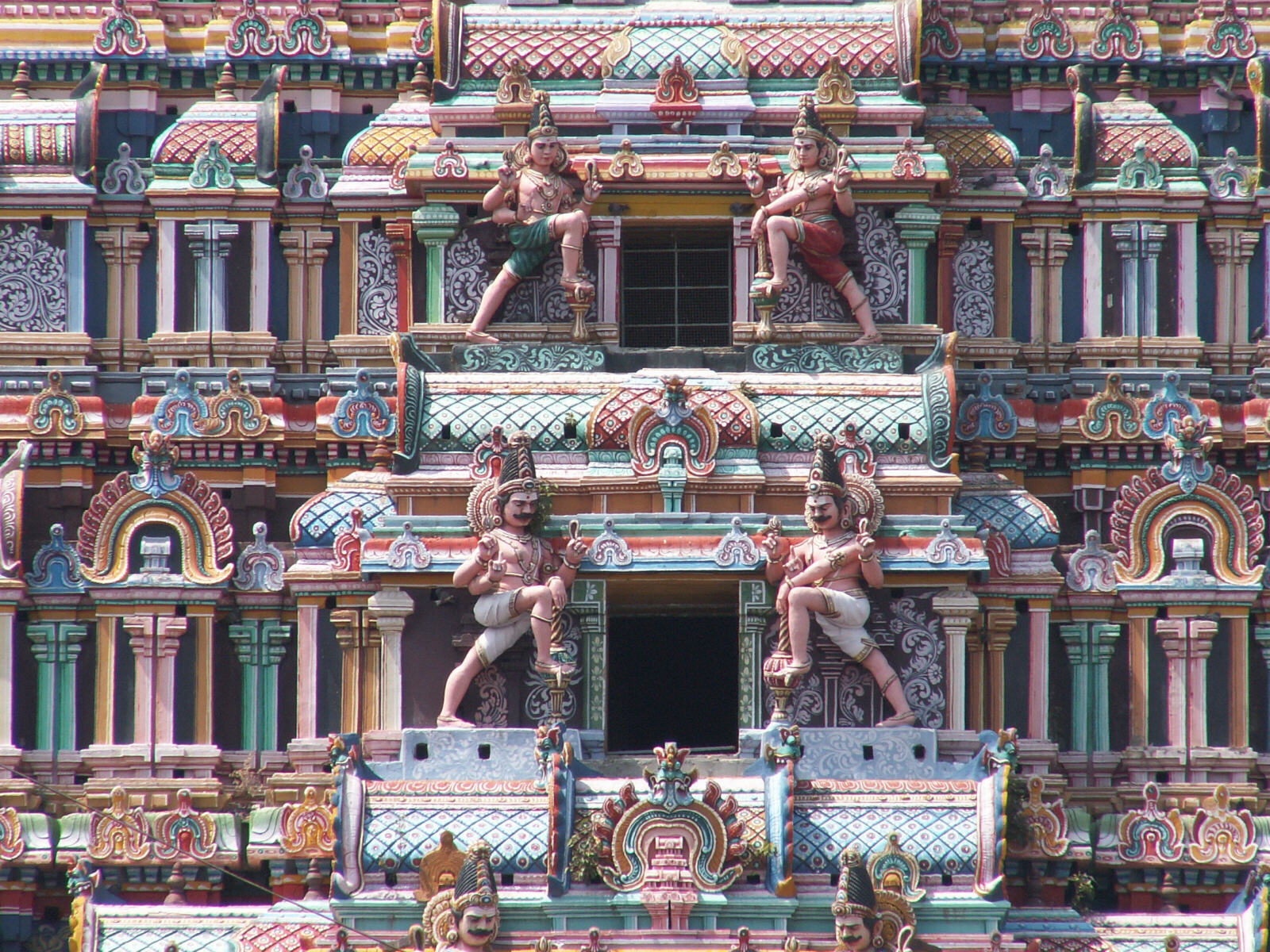
|
We were able to walk all around inside the temple (sometimes parts are closed to non-Hindus), along dark elaborately carved corridors, past colourful shrines to various deities up to the edge of the inner sanctum where a service was in progress with bells and lamps and anointings with milk, and we peered with the crowds right into the sanctum when the priests lifted the curtain to reveal the god.
We arrived in Thanjavur and went to the Hotel Valli down a quiet street away from the endless hooting of the traffic. While Sheila recuperated I had a walk around town, then we went to the up-market Parisutham hotel for a nice meal in their restaurant.
Thurs 7th. Sightseeing in Thanjavur, first the very impressive Brihadishwara temple which has a World Heritage listing. It is another large complex which is still under renovation but is also a functioning temple. Facing the temple is an enormous 'Nandi' (the bull) statue which was carved from a single block of stone and weighs 25 tons. In the afternoon we went to see the former Maharaja's palace with its elaborate high-roofed durbar hall (below), and a multi-storey observation tower which we struggled to the top of, up ever smaller staircases. |
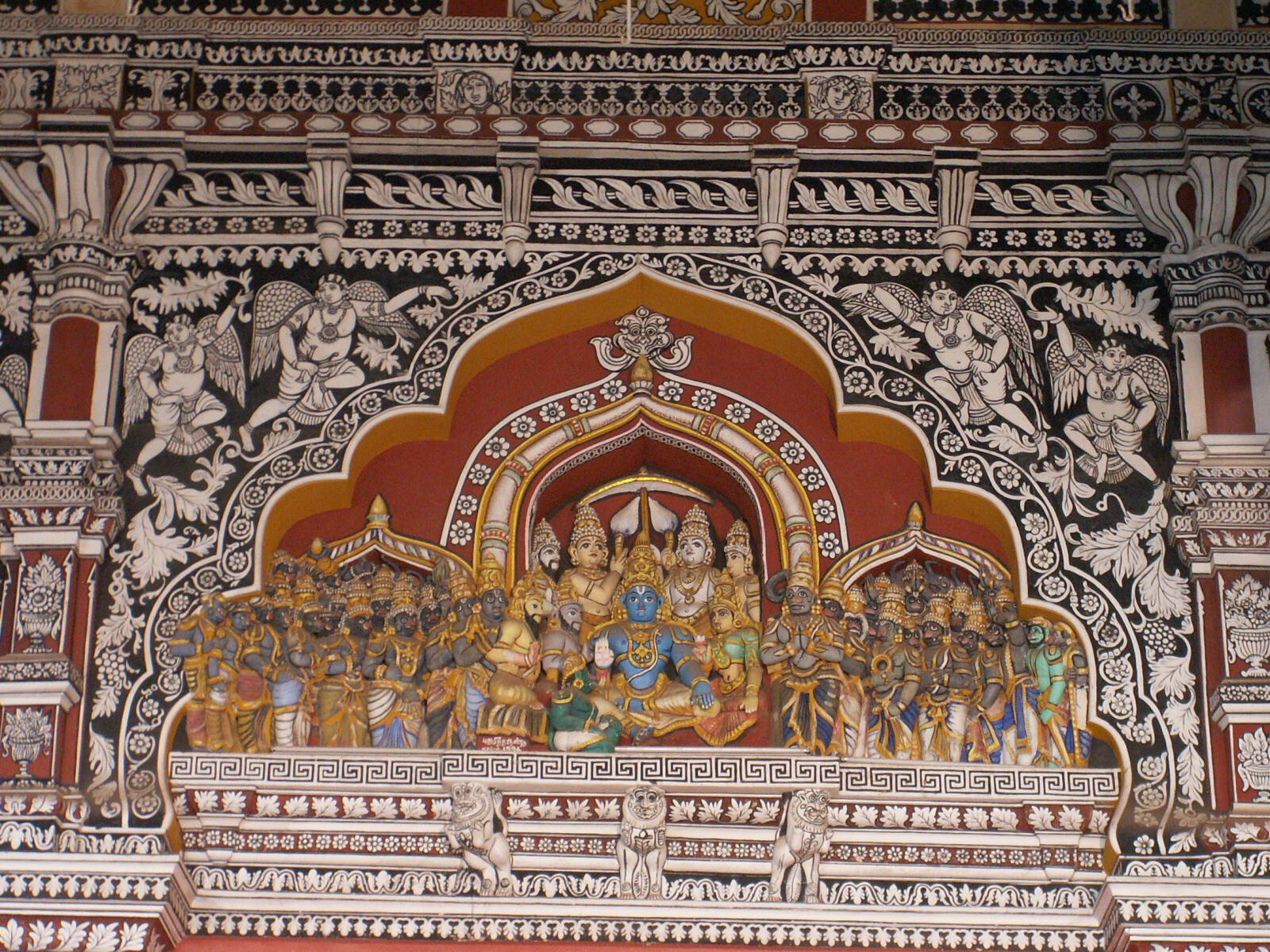
|
- Tiruchirappalli (Trichy)
|
Fri 8th. The Temple Tour continued, as we drove in an Ambassador taxi to Madurai (2,500 rupees), stopping in Trichy (Tiruchirappalli) on the way. Trichy has two very impressive sights, firstly the Sri Rangam temple which is huge, busy and full of well-preserved carvings and small shrines and pillars. The vast complex has seven concentric walls, but the area within the first three is full of bazaars and houses and is more like a town within a town. The area within the last two walls is reserved for Hindus so you cannot even see into the inner sanctum, but there is plenty going on outside including the mandatory temple elephant to bless you with a tap on the head. In one of the large halls was a group of temple priests who seemed to be challenging a small crowd of spectators seated cross-legged on the floor in front of them. I thought it might be a theological debating society, until Sheila worked out that they were actually auctioning cloth and saris! The Sri Rangam temple is huge, busy and full of small shrines and pillars where people worship and leave flowers and little butter candles .... |
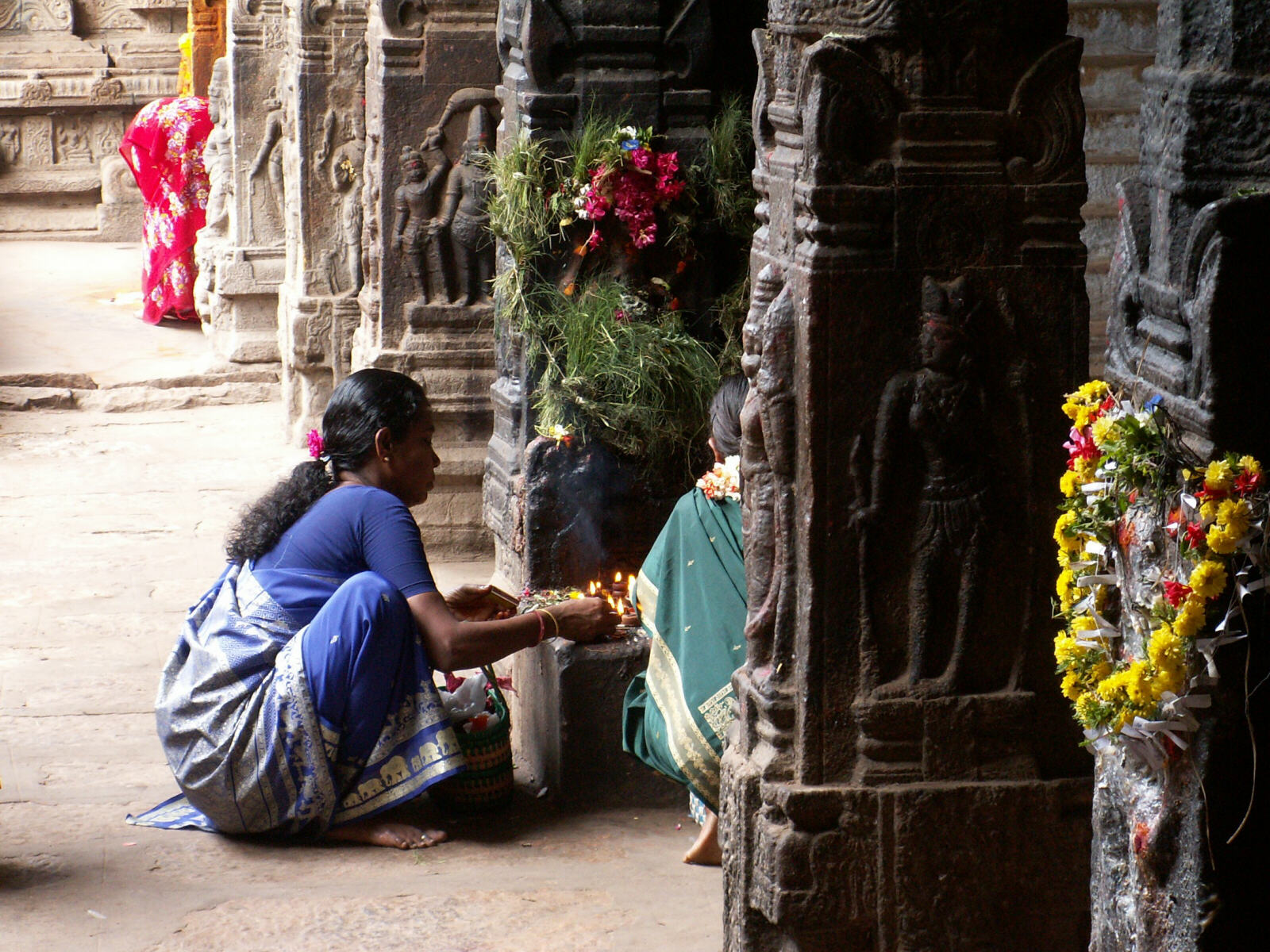
|
.... it also has some impressive, well-preserved stone carvings.
|
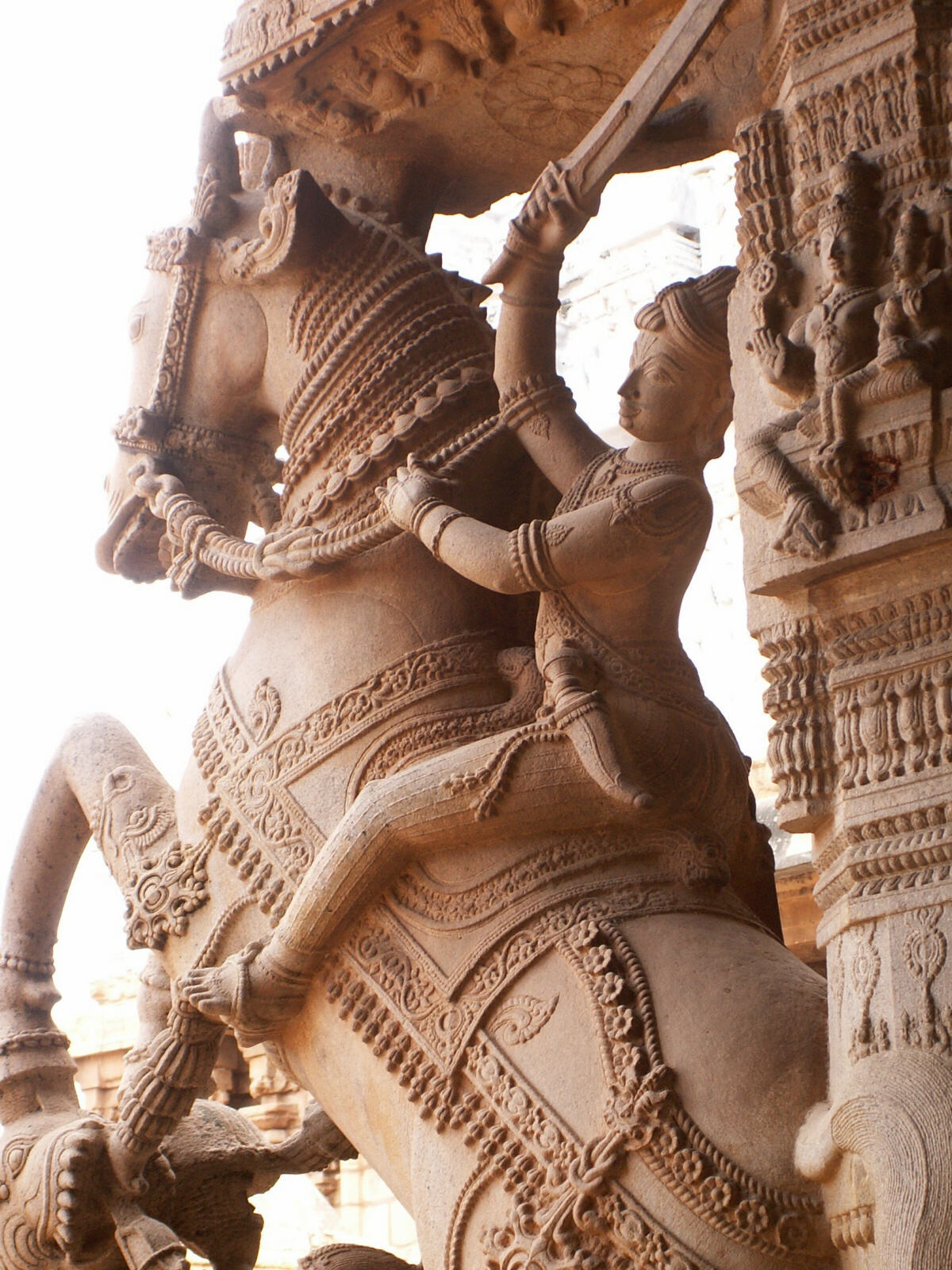
|
We crossed the river into the main town where the other impressive sight in Trichy, the Rock Fort Temple, towers over the old city. The massive rock outcrop rises abruptly from the plain, and there are 437 steep stone steps up to the top, where there is a great view and a refreshingly cool breeze. |
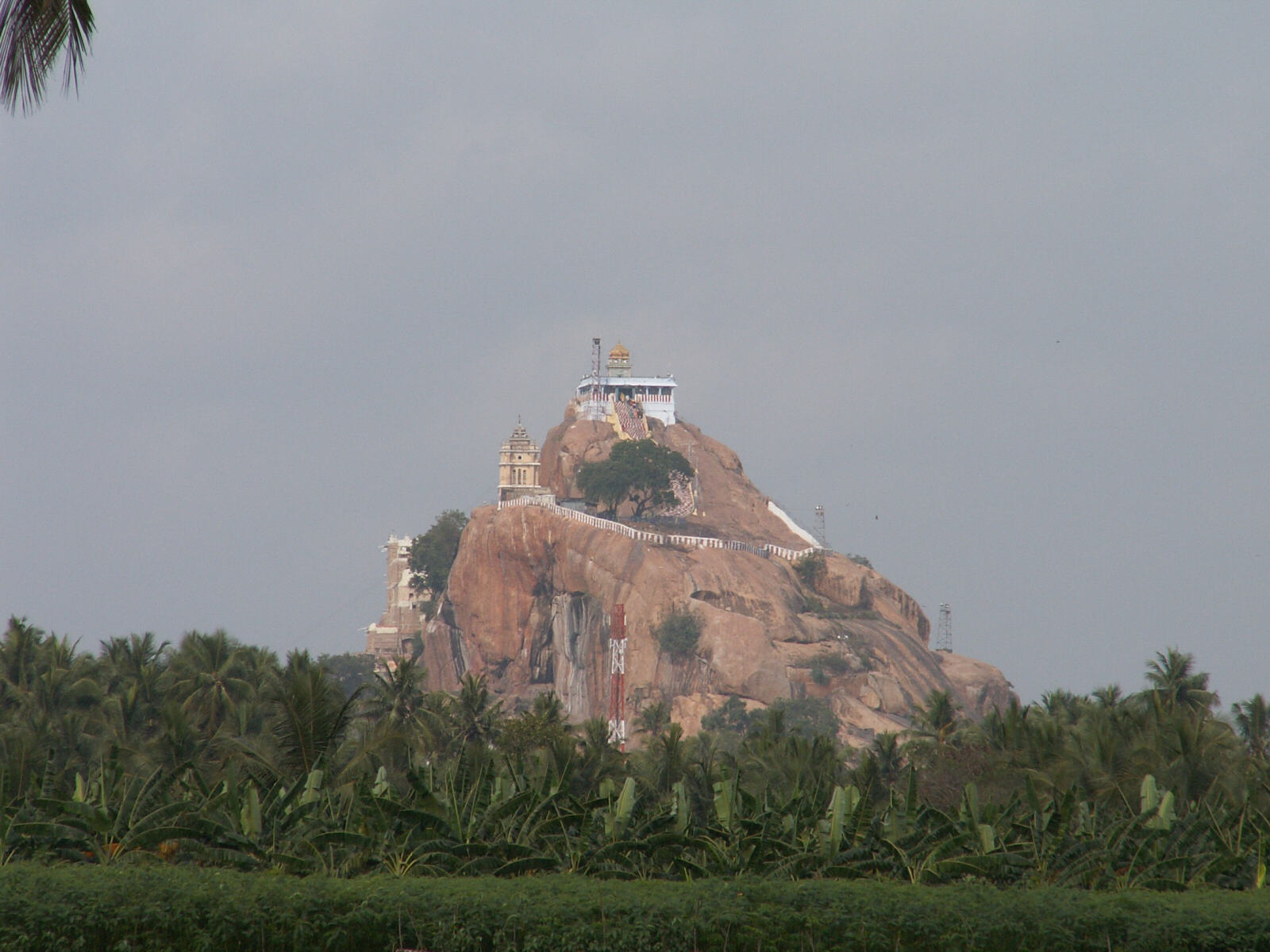
|
On the way down, one of the side halls suddenly opened up and a crowd of people seemed to appear from nowhere all trying to get in. We saw that there were rows and rows of meals spread out on the floor - banana-leaf 'plates' with a mound of rice and vegetable curry with little chutneys. It is a free lunch put on every day by the government for the benefit of pilgrims who travel a long way to worship in the temple at the top of the rock. The organisers beckoned us to come in and sit down, and we tried to decline because the food is supposed to be for the benefit of poor pilgrims, but they insisted and bustled around us showing us where to sit, cross-legged on the stone floor, and how to eat, kneading the rice and curry together into a blob with your right hand then trying to get it into your mouth without spilling it everywhere - not easy! Most of the other pilgrims had finished and left, leaving no trace, by the time we stood up in the middle of a mess of rice and other debris all over the floor around us, and went to the hand-washing tank, but it was great fun. |
- Madurai
|
When we arrived in Madurai after several hours driving through continuous road works (they are turning the road into a dual carriageway) we found that all the hotels were full, as we had been warned they might be because the town fills up with visitors at the weekend. One full hotel recommended the Temple Park hotel and called to make a reservation for us there, and it turned out to be a nice hotel in a great location, near one of the entrances to the main temple. After checking in we went to the railway station to try to book the train to our next destination. There was a very efficient and well-organised computerised booking office, with orderly queues, but unfortunately it turned out that the train we wanted is a 'passenger' class, meaning it is a local train with no reservations and a free-for-all scrummage to get one of the wooden seats when the train arrives. We decided against that and went to the rooftop Temple View restaurant at the Hotel Park Plaza to consider other options. We had an excellent meal of tandoori chicken and chicken do piazza - north Indian rather than local dishes, but very nice.
Sat 9th. One thing we didn't realize about the Temple Park hotel is that there is an all-night market in the street outside, and although we were on the third floor, market people clearly need to make as much noise as possible to maximize their sales. We spent the morning messing about changing to another room, finding transport to Rameswaram tomorrow and also booking a hotel there because it gets very full, and also visited the fascinating (daytime) vegetable market opposite the hotel, which was busy with people coming and going carrying impossibly heavy loads, and cows browsing among the debris and occasionally on the goods for sale. |
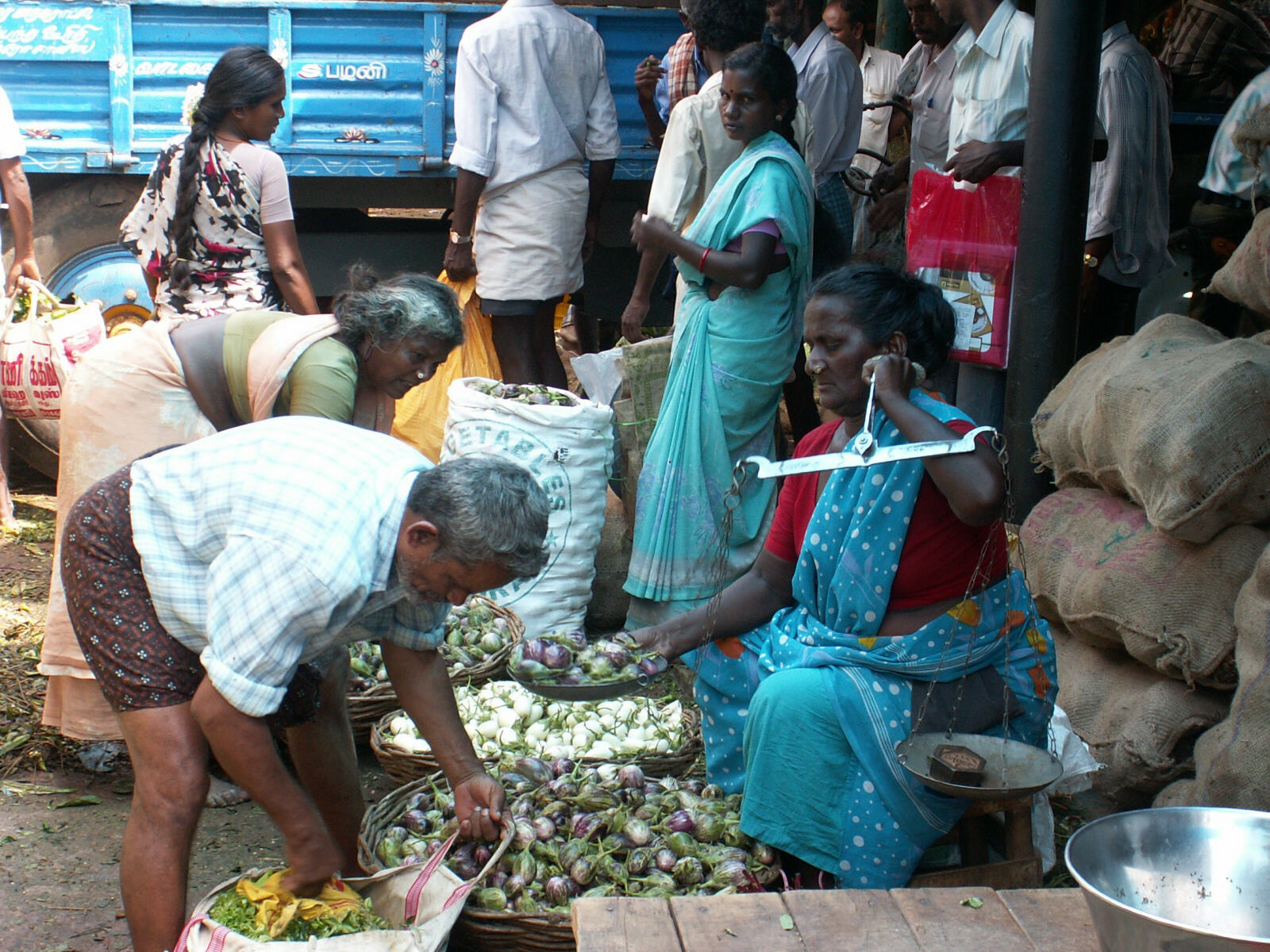
|
Then in the afternoon a tropical rainstorm appeared from nowhere. |
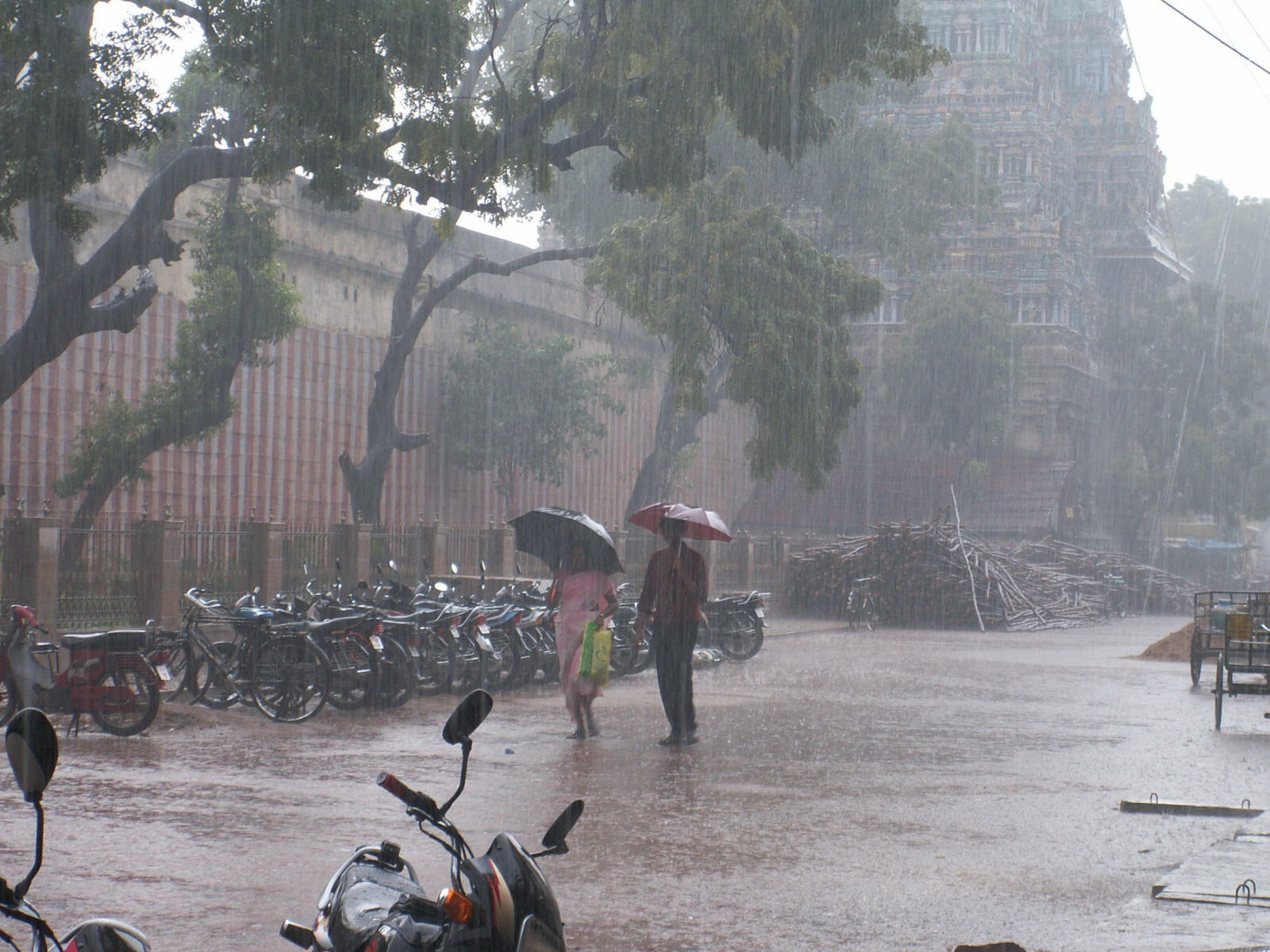
|
It poured with rain for a couple of hours, so that by 5pm we still hadn't been to the main attraction in Madurai, the Meenakshi Temple. It was only just down the street from the hotel but we had to wade through knee-deep floods to get there. Most of the temple is under cover but we also had to wade through some of the connecting corridors which had turned into swimming pools. It's another wonderful, busy, bustling, colourful temple, with bazaars in the great hall that used to be the stables for the temple elephants, devotees worshipping and lighting candles at the many shrines and of course the temple elephant; Sheila always has to have lots of small change because she likes to be blessed a lot! Below is the 'golden dome' above the inner sanctum of the Meenakshi temple. This view is only available from the roof of nearby shops, so you have to be prepared to go through the sales pitch to see it. |
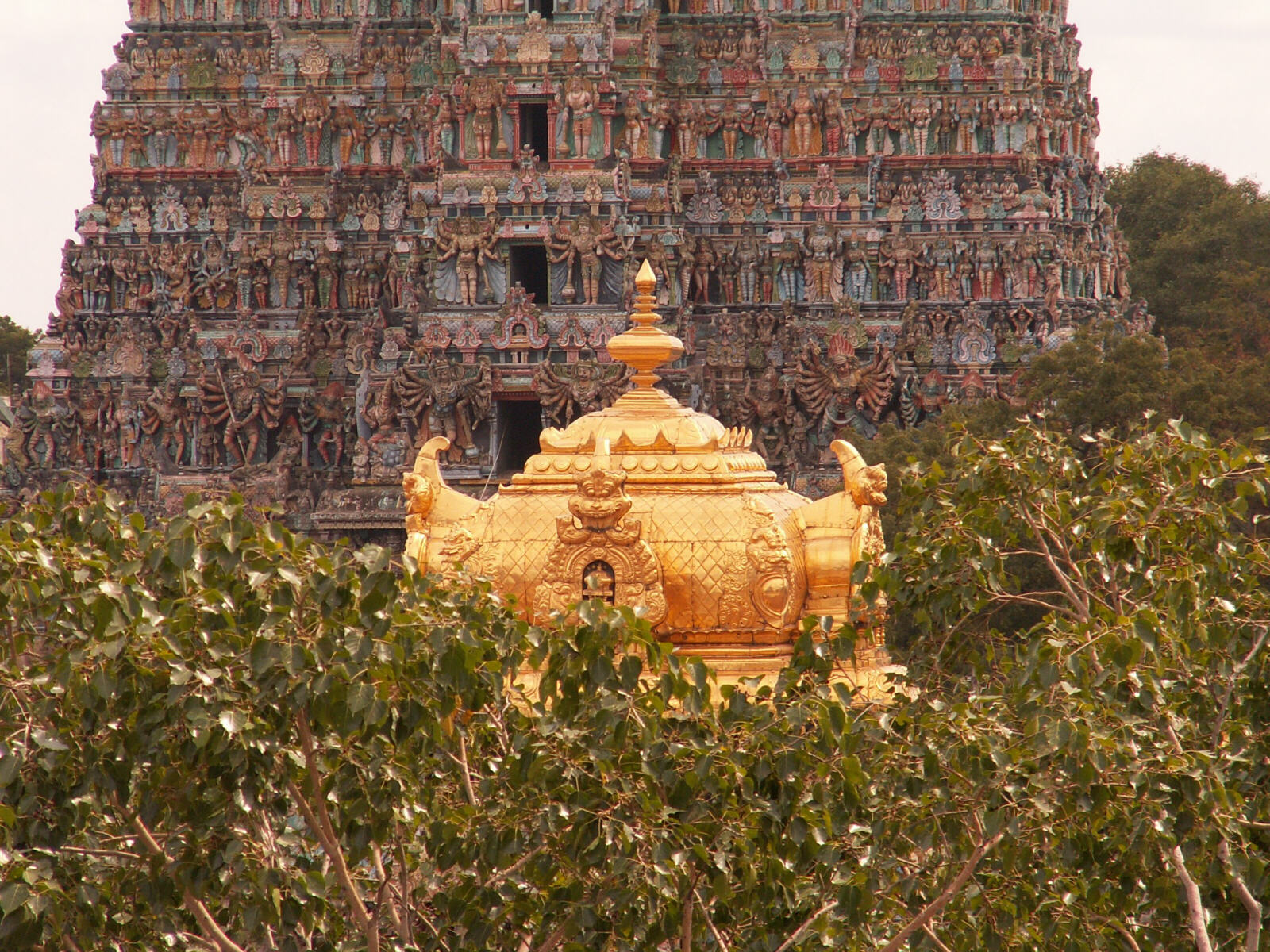
|
Rameshwaram
|
Sun 10th. The Madurai night market didn't just happen in the street, it took over the whole street. When we went down to reception to wait for the minibus which is coming 'at seven o'clock', the entrance to the hotel was blocked by cauliflowers and the whole street was completely blocked by lorries, sacks and piles of vegetables, with people fetching and carrying in all directions. The minibus arrived at 7:45 with two other English tourists, then we went to pick up the remainder of the passengers, an extended Indian family and friends with their luggage, who seemed to be on a pilgrimage. Once we got going, the drive to Rameshwaram was fine, three hours along a good road and over the Indira Ghandi bridge onto the island, but when we got there we spent ages waiting about while the pilgrims tried to find a hotel cheap enough to stay in. Eventually we went to do the promised sightseeing, including a good view from a small hill and the Temple of the Amazing Floating Stones (they were pumice). The bus then dropped us at the Tamil Nadu hotel, a typically run-down government hotel in a lovely position by the sea. We had lunch in the hotel restaurant where the only option was a 'thali meal', the standard south Indian plate of rice and several tasty little curry dishes. Any leftovers were quickly eaten by the crows whizzing through the windows and dive-bombing the plates. After a rest we set off in a tuk-tuk to the fishing port, which was still bustling with activity late in the afternoon. Baskets of small fish were everywhere .... |
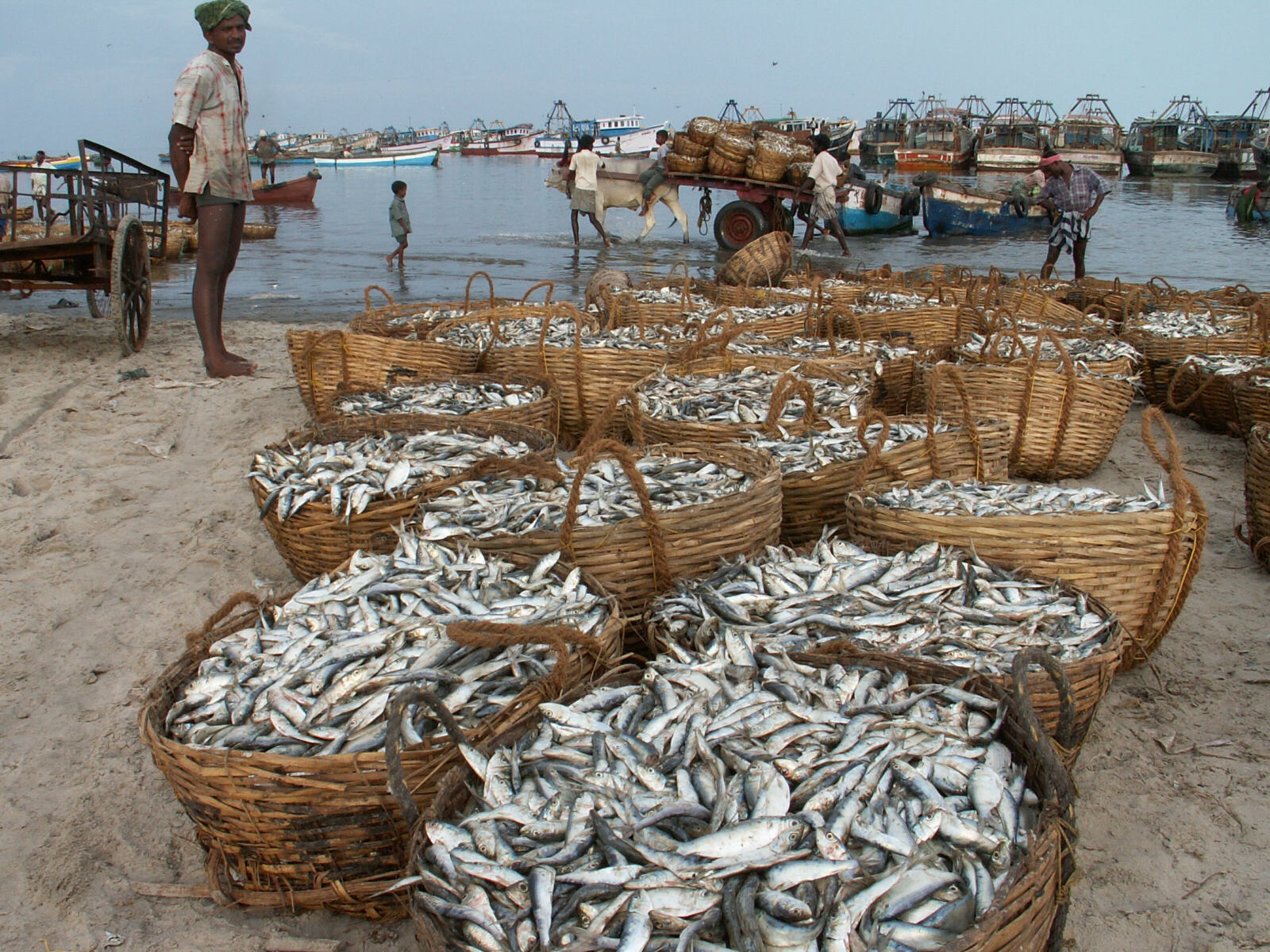
|
.... men were unloading them from boats and carrying them through the shallow water to the shore .... |
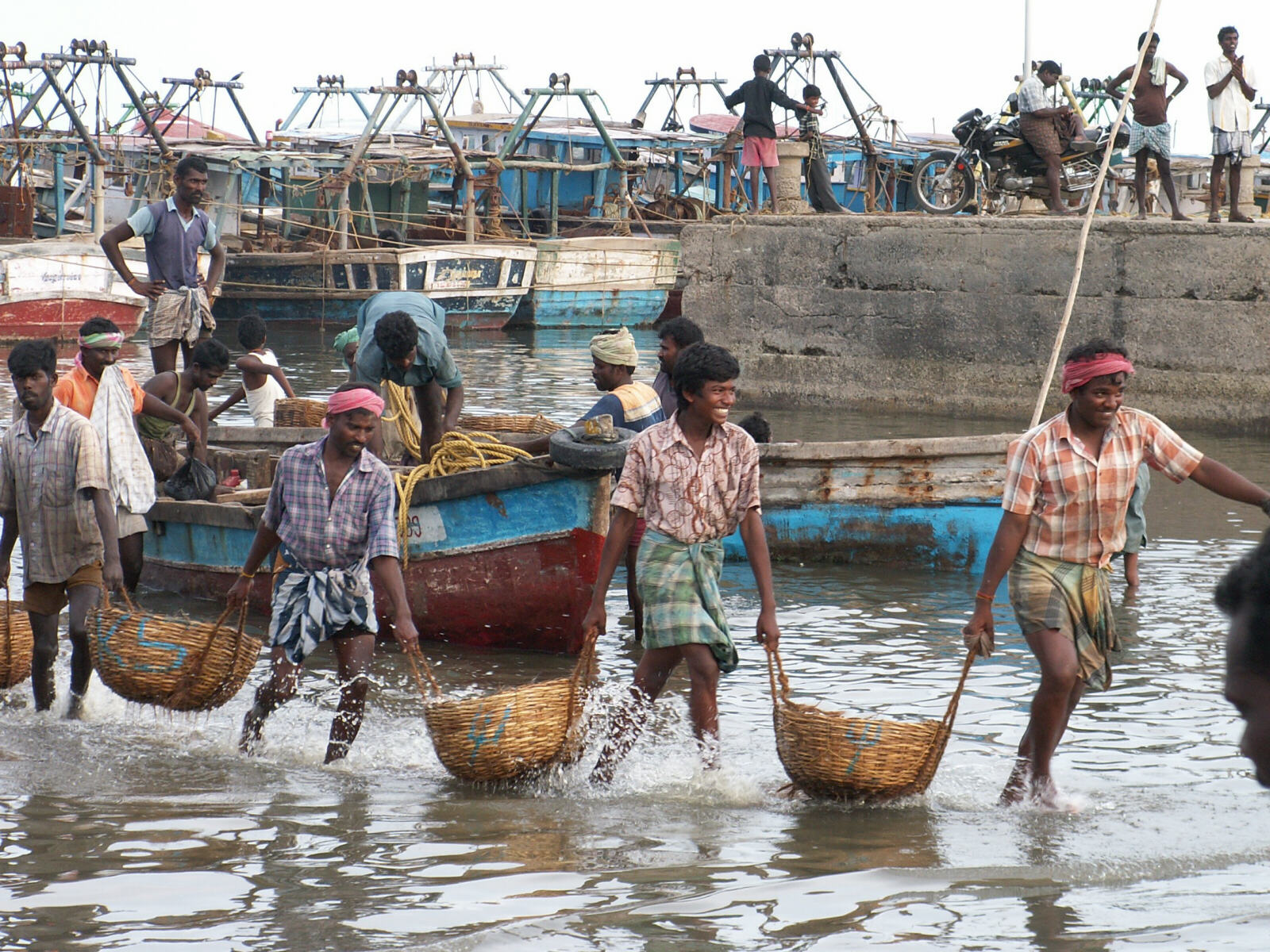
|
.... where other men were piling them onto carts pulled by oxen who appeared to have mutant chilies on their heads (actually brightly-painted horns) and when the cart was loaded the oxen plodded lazily away and another took its place .... |
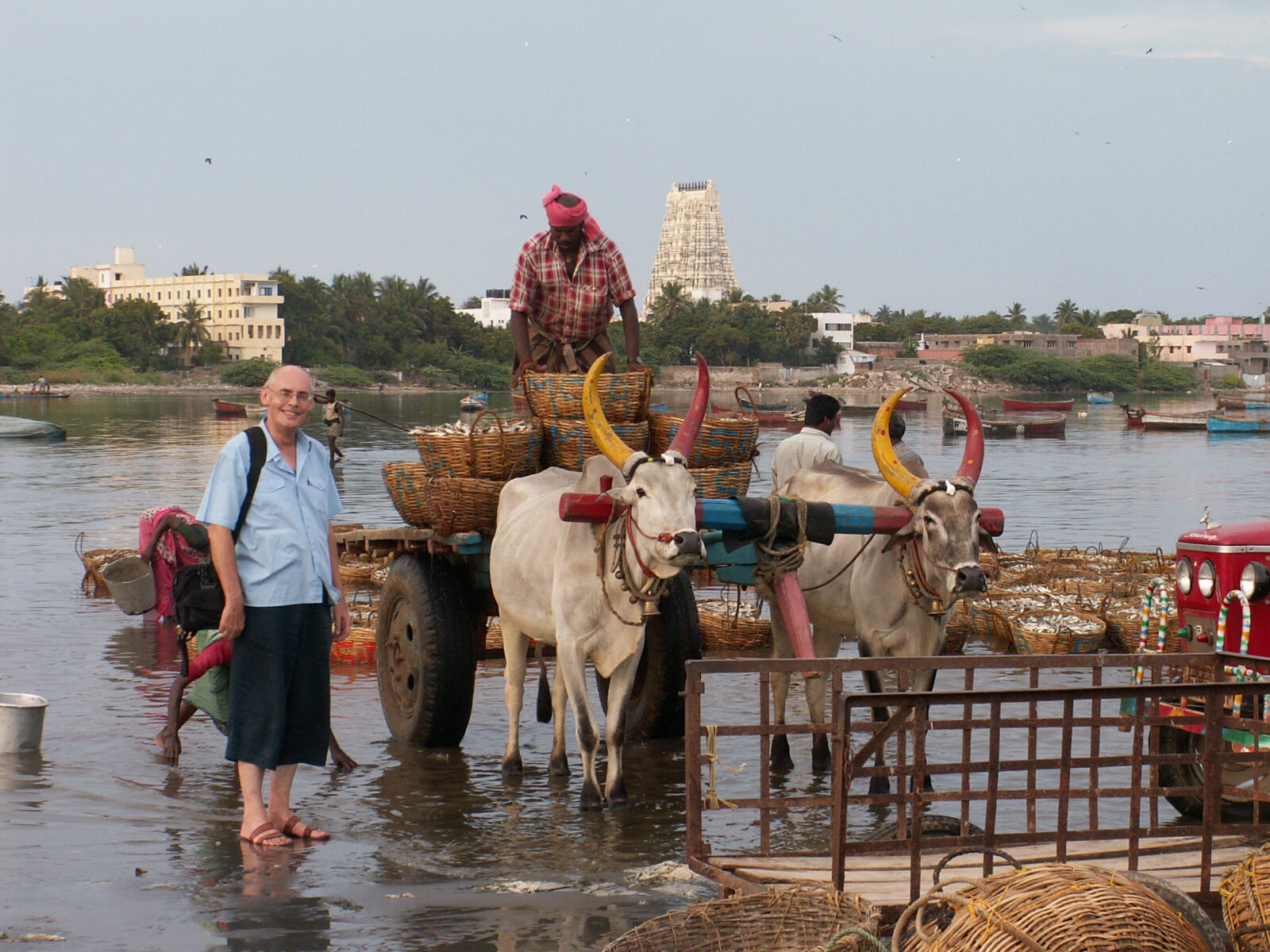
|
..... while all the time ladies were sifting through a layer of small fish spread all over the sandy shore. We stood and watched the activity for some time, taking photos and enjoying the atmosphere (despite the strong fishy smell).
Then at last we went to Ramanathaswamy, the main temple and one of the most sacred in India. One of the key aspects of the pilgrimage here is to be doused in water from the 22 holy wells within the temple complex, and a stream of dripping wet, shivering pilgrims were moving from well to well and standing there while the priest hauled up a bucket of water and threw it over them. We declined the offer, but I did have a sip of 'sacred Ganges water' (Sheila, still unwell, was taking no chances). We walked round the small town looking for something to eat but this was less successful - Rameswaram caters for pilgrims not tourists and all we wanted was a bowl of soup to get rehydrated, but there was no soup to be had anywhere, so we settled for a Mars bar.
Mon 11th. This morning was a lesson in how unreliable everything in India can be. Yesterday the man in charge of the reservations office at the bus station told us the bus to Kanyakumari is a deluxe aircon bus which leaves at 7am so we should be there at 6am to reserve a seat. The hotel tuk-tuk man promised to be at the hotel at 6 to take us to the bus station. All well and good. In the event the tuk-tuk man didn't show up and the hotel had to send someone on a motorbike to fetch him, when we eventually got to the bus station at 7 there was nobody there, and we found out that the bus is not scheduled to leave until 7:30. However, the bus did not show up either until nearly 8 and there was a long pause while they unloaded some big ships' propellers from inside it. It was not a deluxe aircon of course, but a dusty old local bus. Then, we almost missed it entirely because while we were still waiting for someone at the reservations office to sell us a ticket, it started up and was ready to go. We left with just four passengers on board, so clearly reservations are not necessary. |
Kanya Kumari
|
It was a long, dusty and bumpy 10-hour ride to Kanya Kumari but although other passengers did get on, it never filled up so we had room to spread out and doze, which almost made it bearable. The bus took us right to the centre of town and from there we let a tout guide us to the Hotel Maadhini where we got a reasonable room with a fabulous view for Rs 1200. Kanya Kumari (Cape Cormorin) is the Lands End of India - the southernmost point on the landmass, and from our balcony we had a wide vista of the sea and the illuminated memorial on the island just off the end of the cape. We went next door to the rather more expensive Sea View hotel for a nice meal in their restaurant, our first food since yesterday lunchtime.
Tues 12th. We were up early for the sunrise over the sea, but unfortunately a bank of clouds in the east got in the way. We went sightseeing in Kanyakumari, walking down the touristy little main street to the Kumari Mamman temple, built right at the 'land's end' near the sea, where non-Hindus are welcomed and (for numerous small donations) taken through the 'puja' and presented to the god in the inner sanctum. Then we walked round behind the temple and down the bathing steps to dabble our feet in the three seas - Bay of Bengal, Arabian Sea and Indian Ocean. We then braved the rough seas to take the ferry for the short ride across to the Vivekananda Memorial on the rocky island off the coast. |
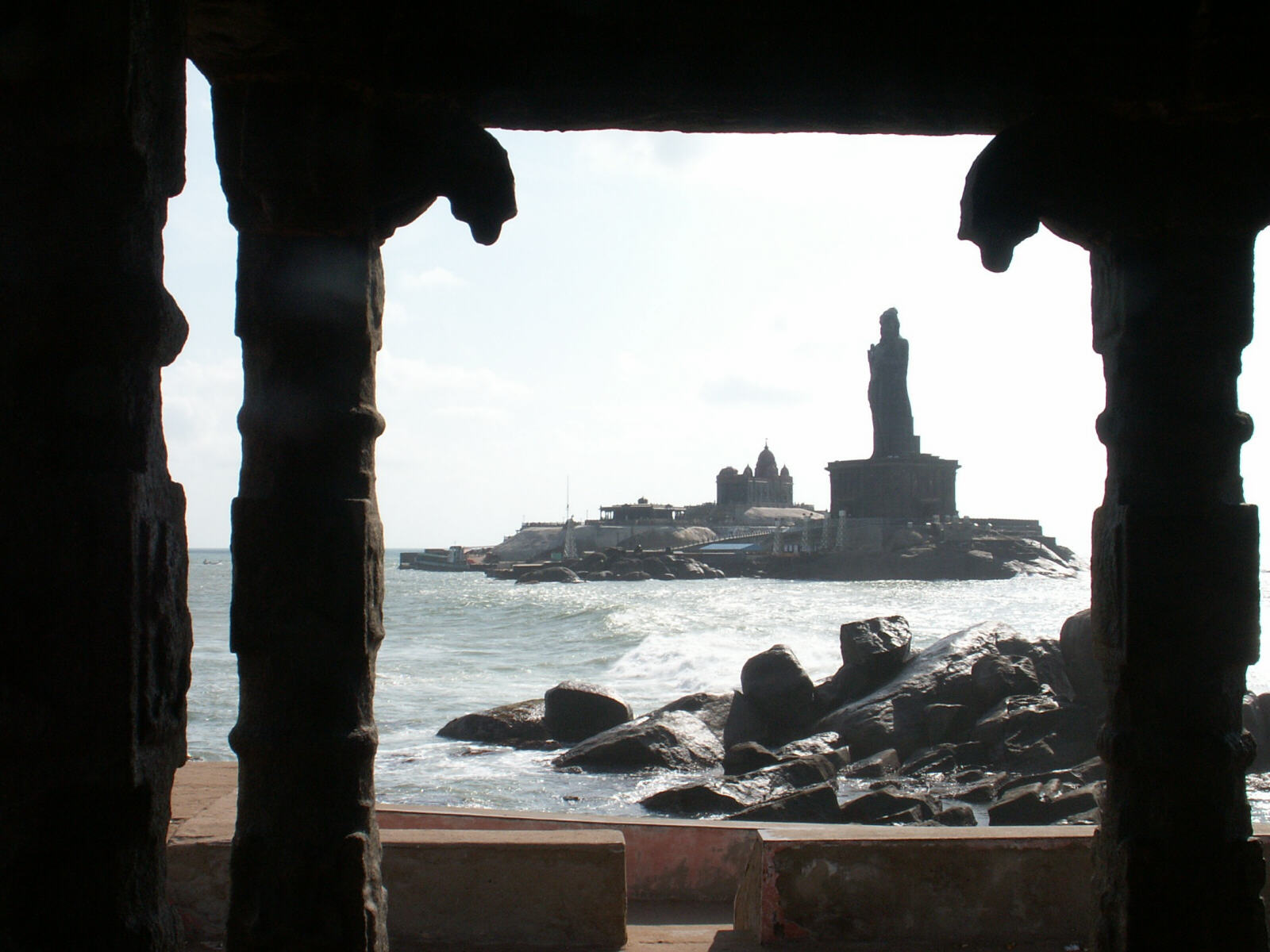
|
The place where three seas meet - the Bay of Bengal, Arabian Sea and Indian Ocean.
|
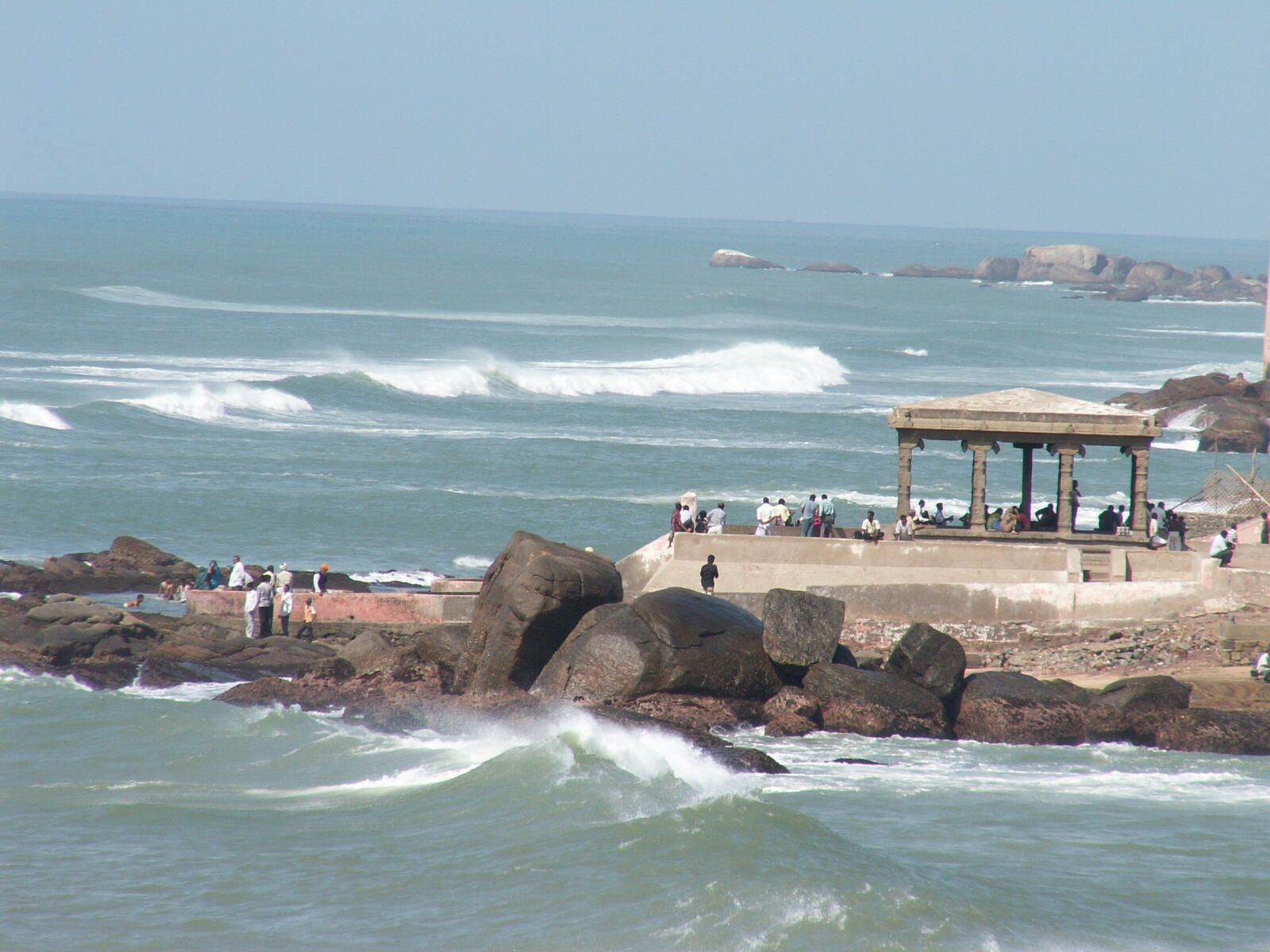
|
When we returned to dry land we had idli and dhosa (south Indian snack meals) for lunch at a little local restaurant in the tourist street, then we went to the railway station to buy a ticket for tomorrow's train - again there are no reserved seats but he promised us that the train would not be crowded and the seats would be 'comfortable'. We got a tuk-tuk to the government-run hotel Tamil Nadu, which is in a nice position overlooking the sea and looks much better cared for than the one in Rameswaram. As well as normal hotel rooms you can stay in 'cottages' which are very nice self-contained suites in separate buildings in the grounds. We walked back into town along Beach Road, stopping to look round a very interesting aquarium and to buy a little paper cone of chickpeas with onion and coriander from a street stall, and a mango Mivvi ice lolly from an ice cream vendor. The bathing beach at the southern tip of town was packed with people paddling and body-surfing or dodging the waves, just like Blackpool in saris, and we sat and watched the fun as the sun went down. |
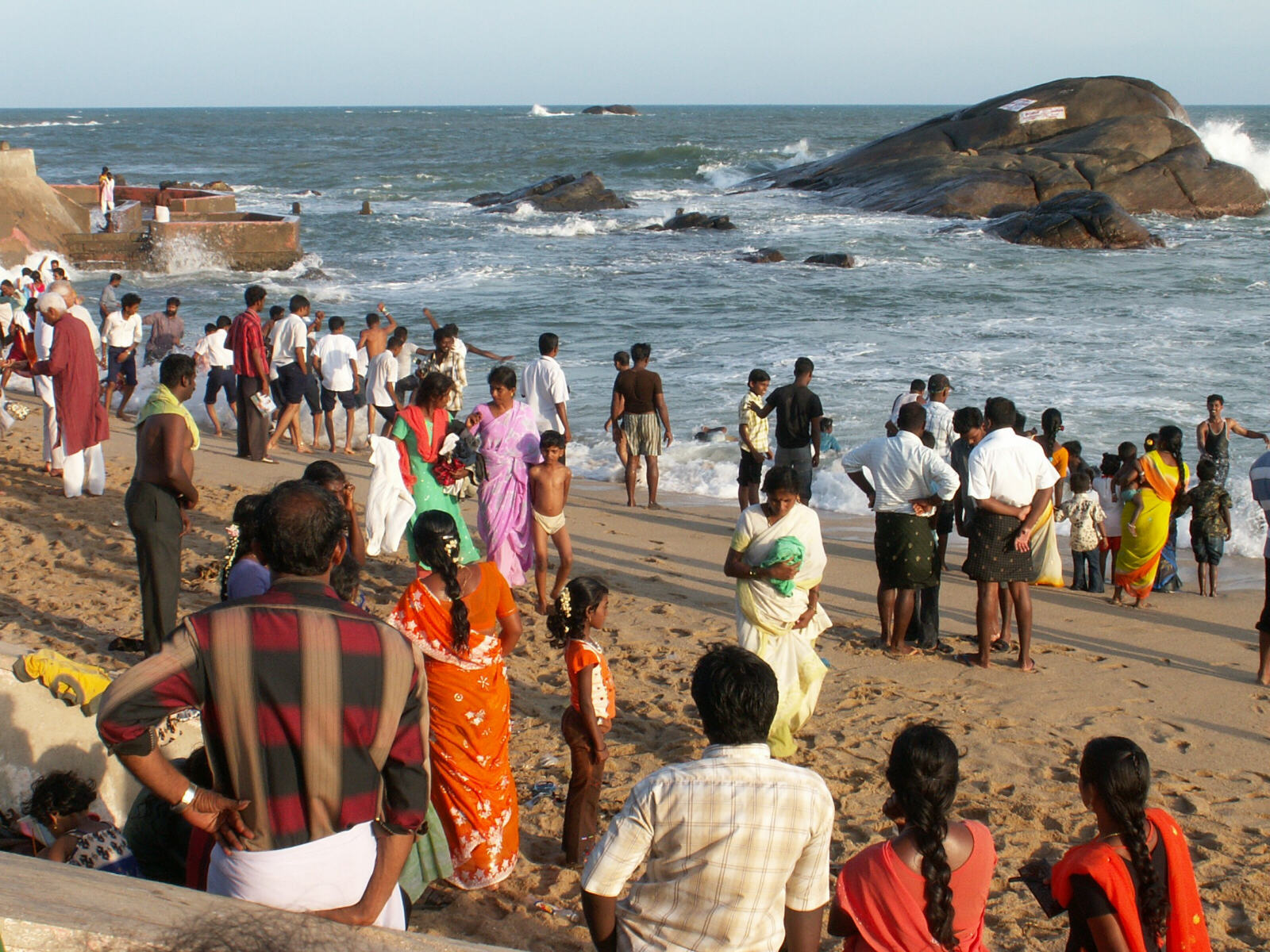
|
This time there was a bank of clouds in the west, so we were unable to witness either a sunset or sunrise over the sea, which is promoted as a unique combination only visible from this place. |
To continue to part 2, Kerala Palaces and Backwaters, please click on Ganesh.
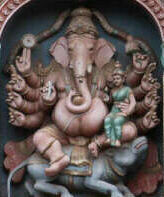
|
